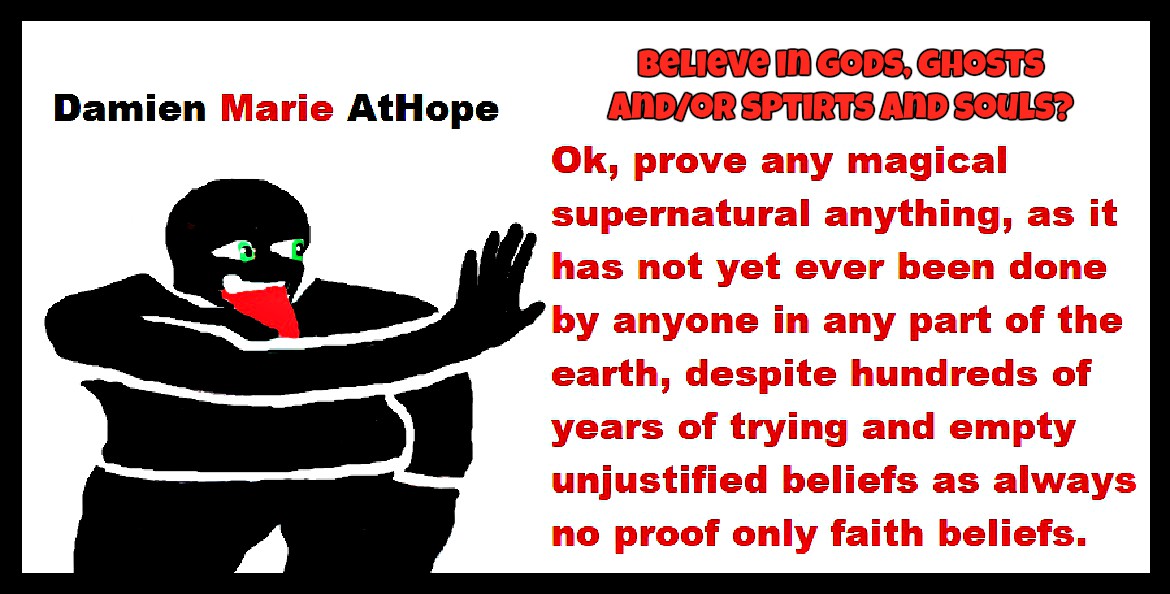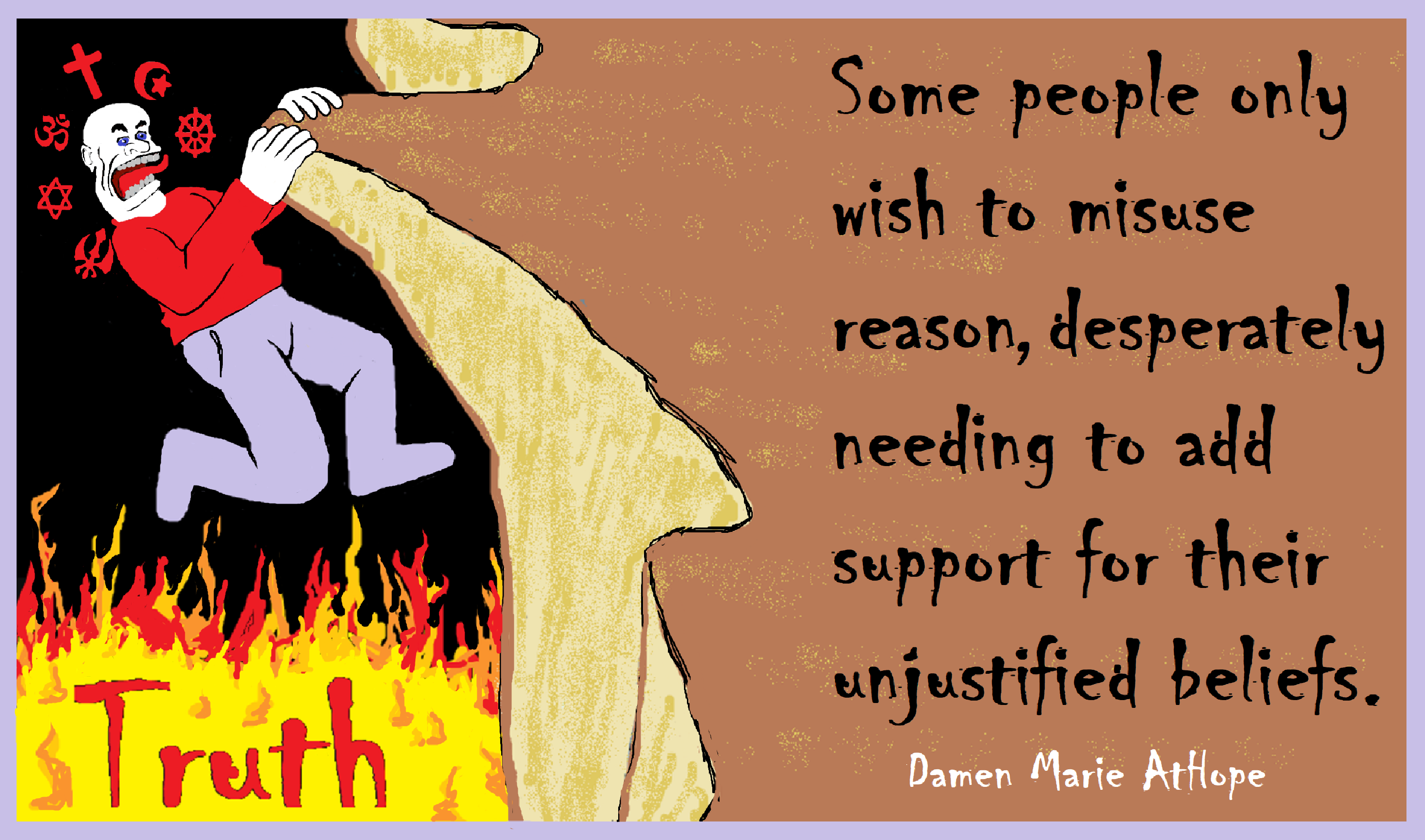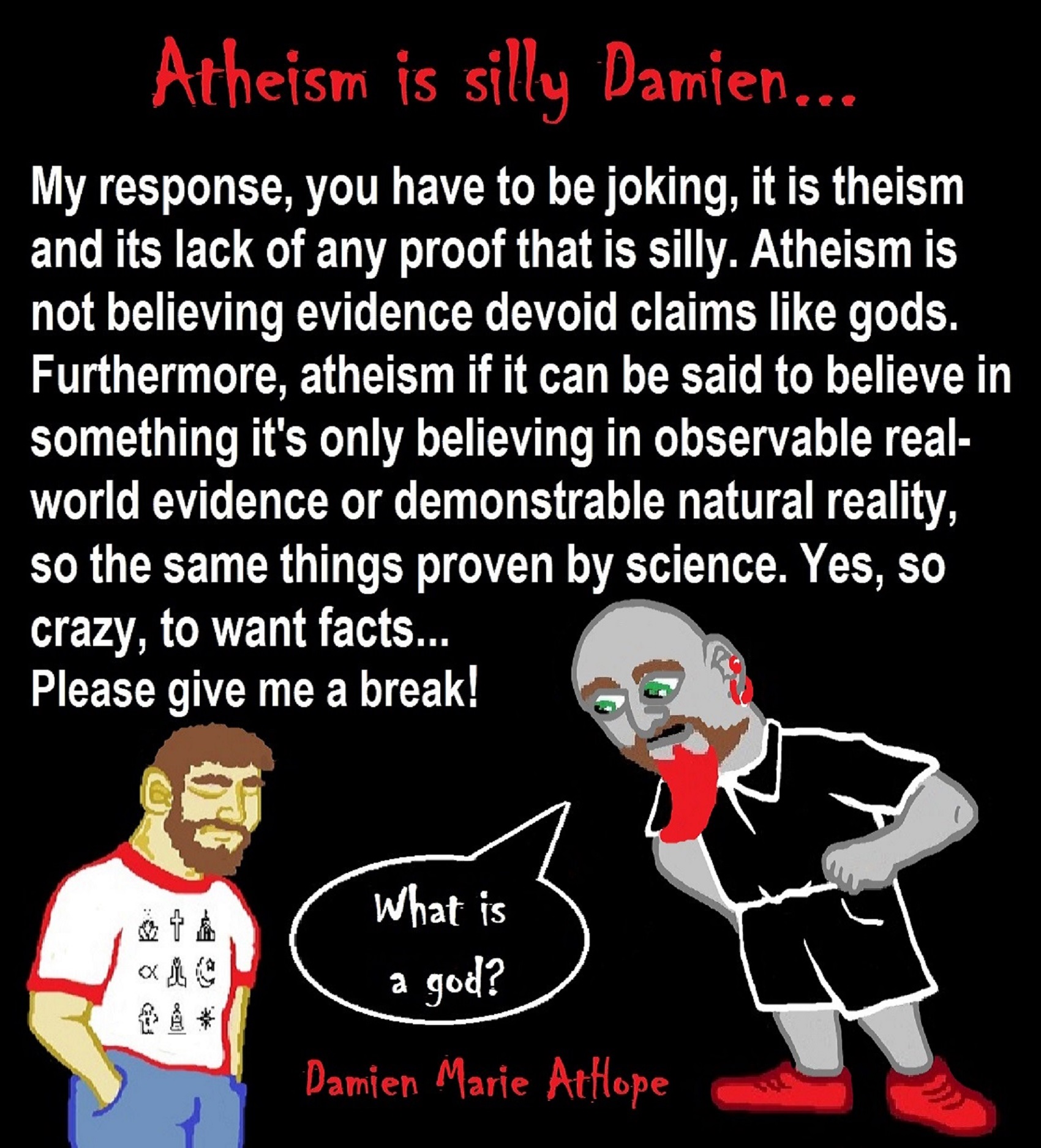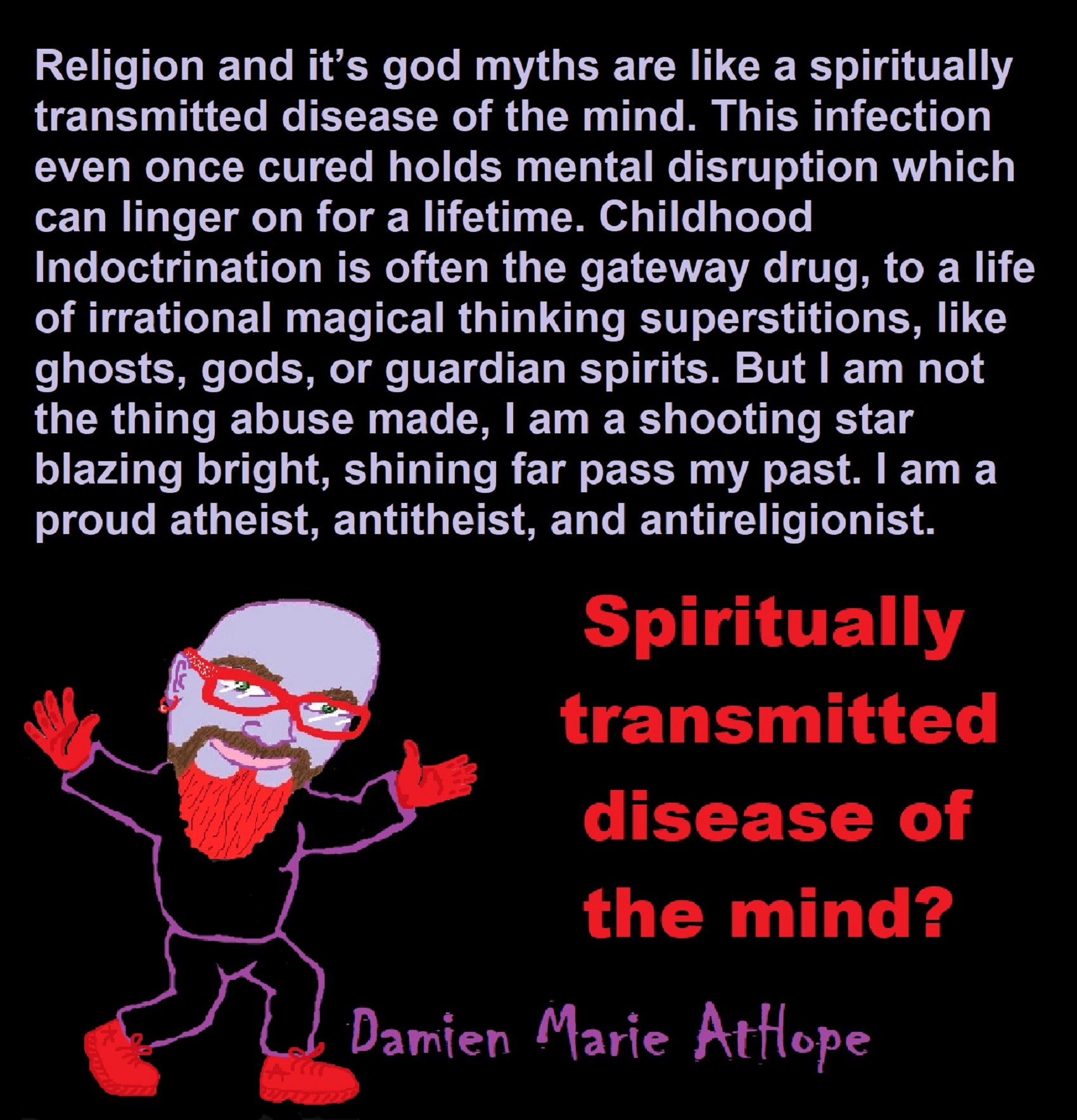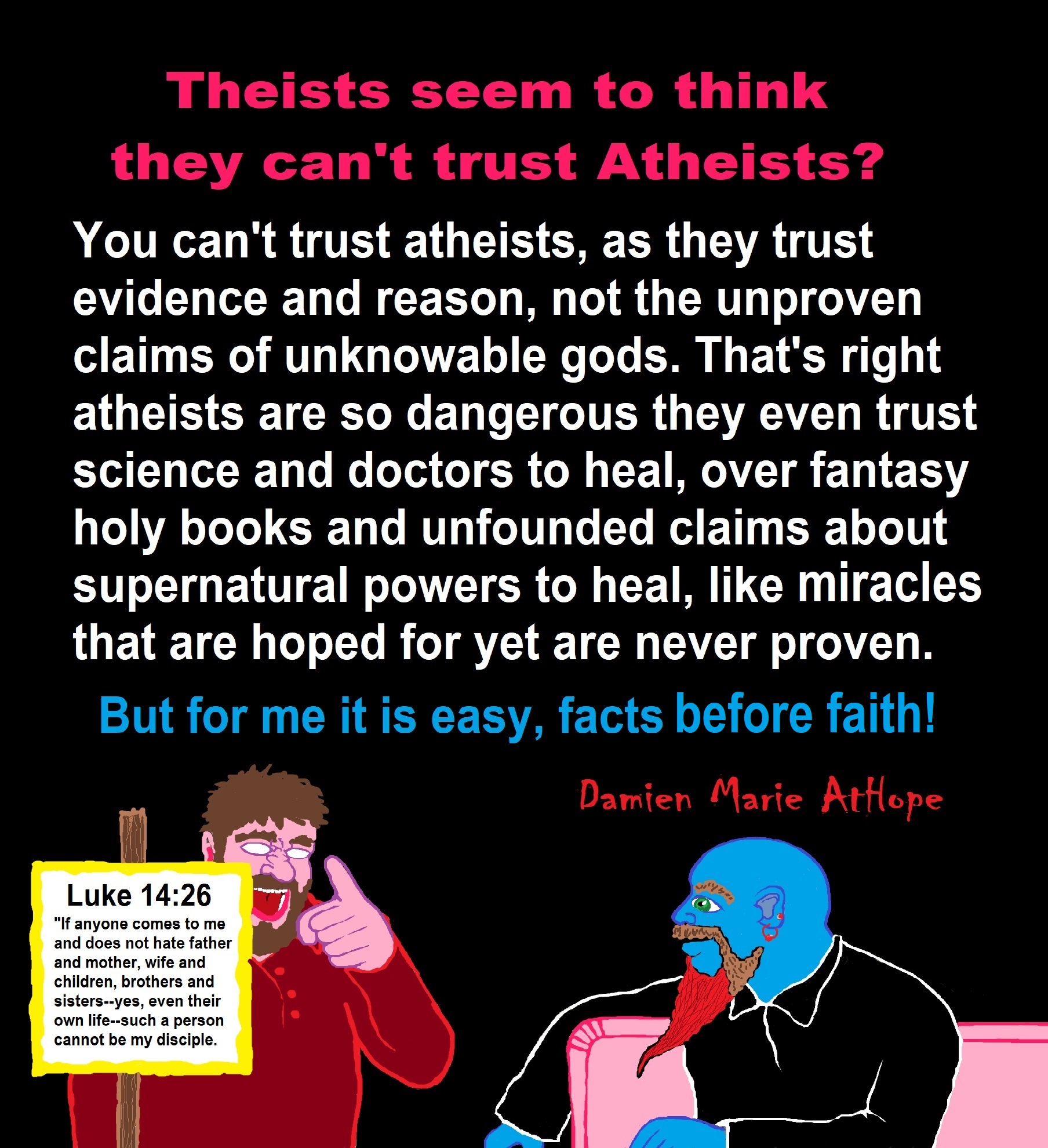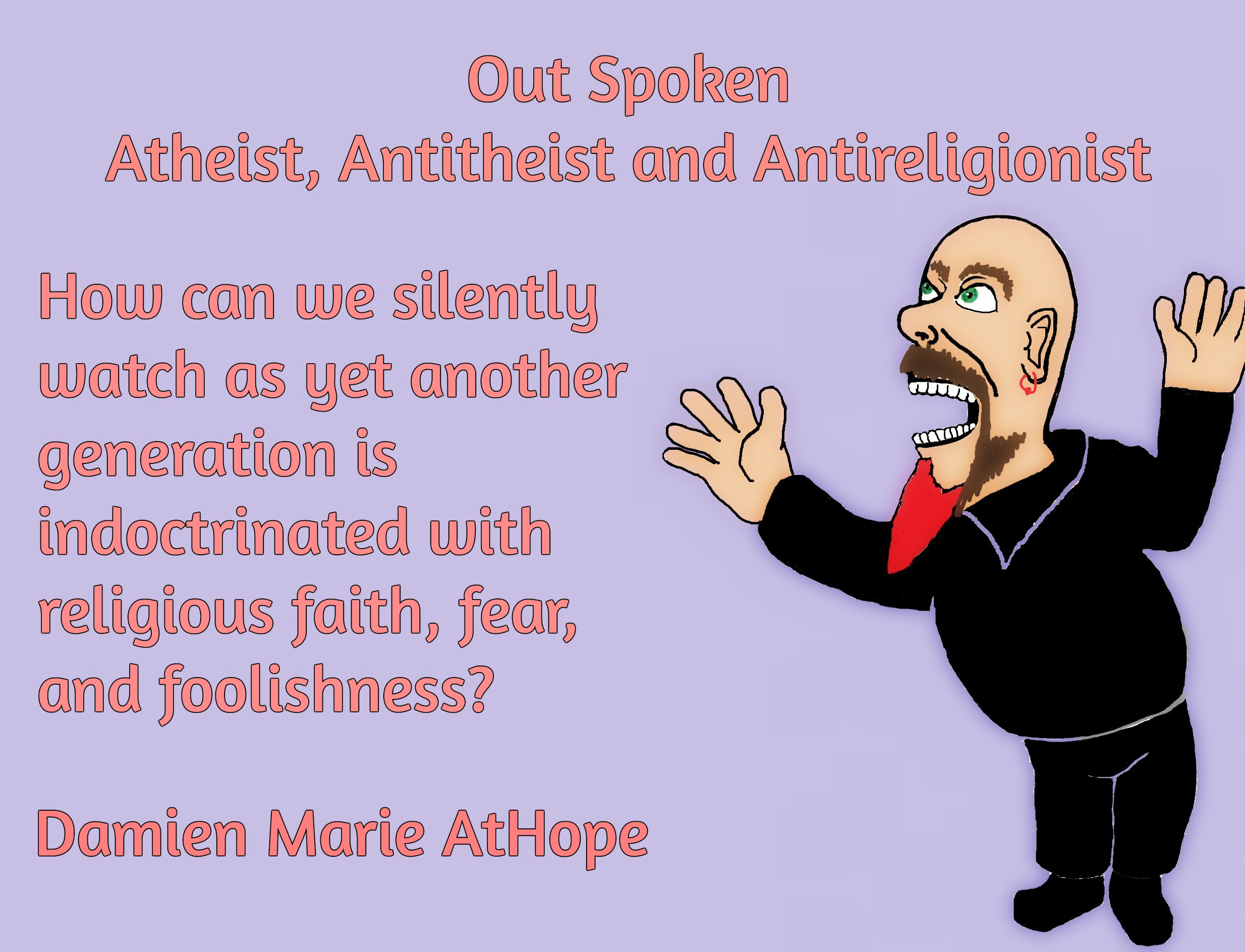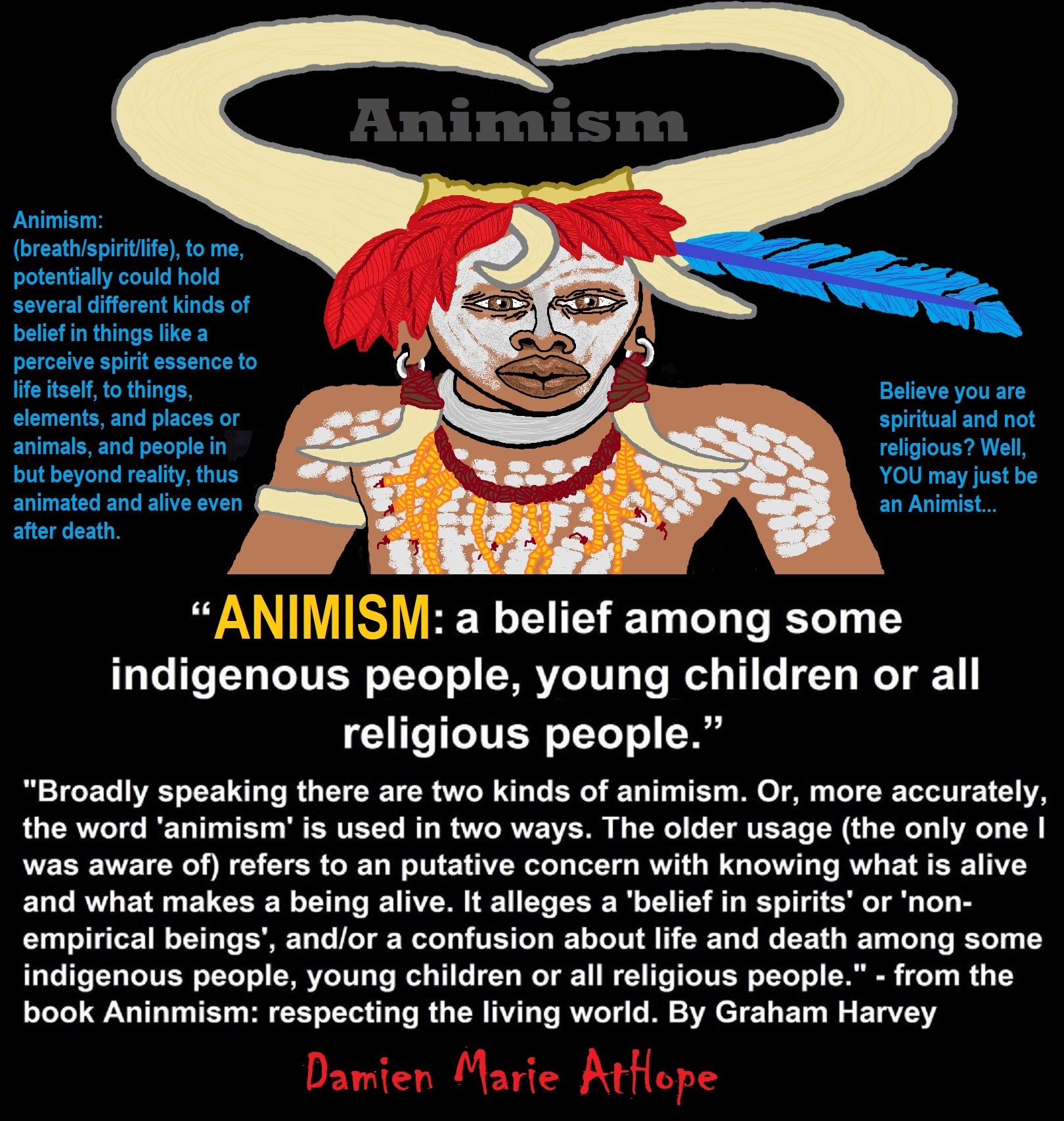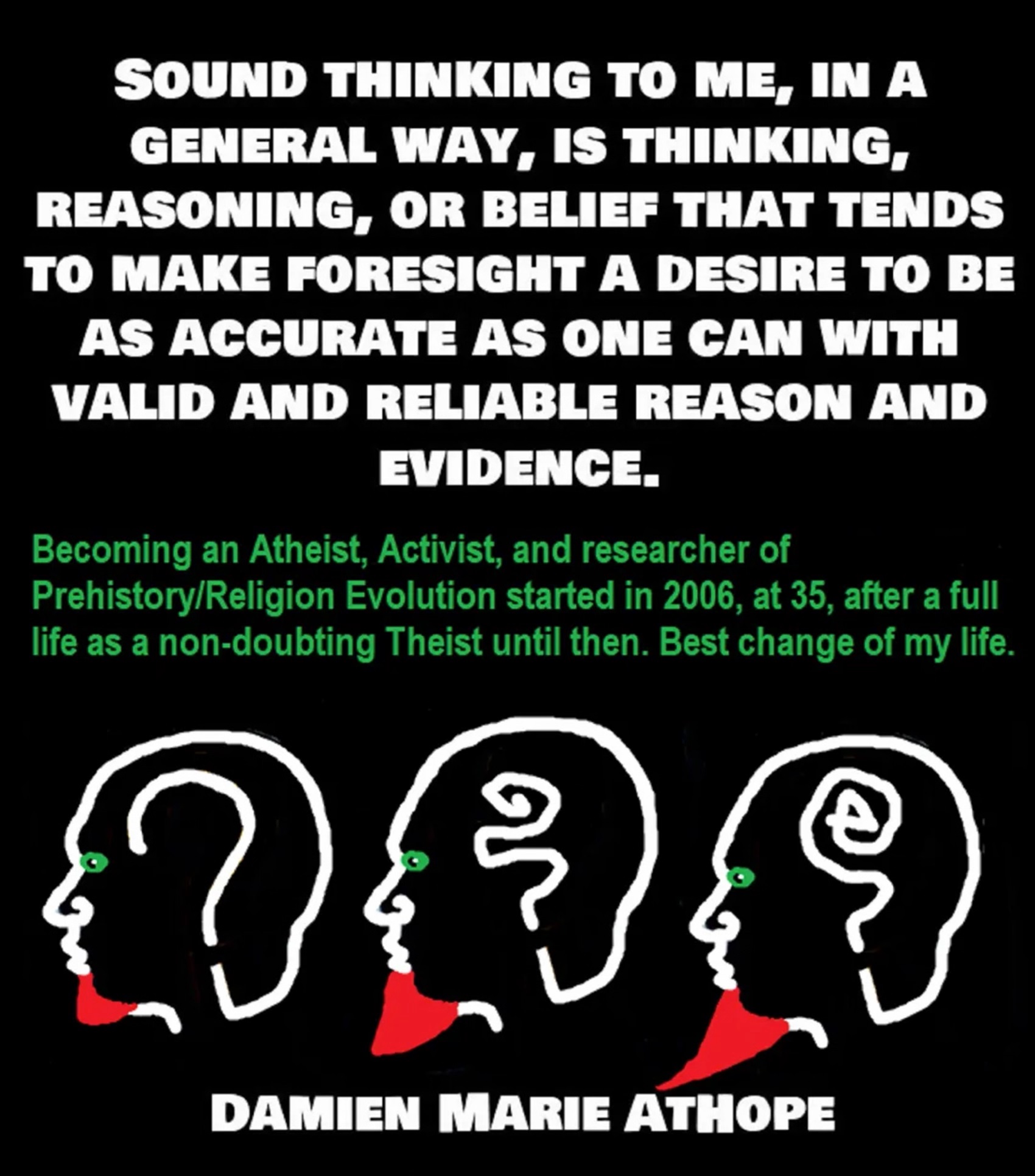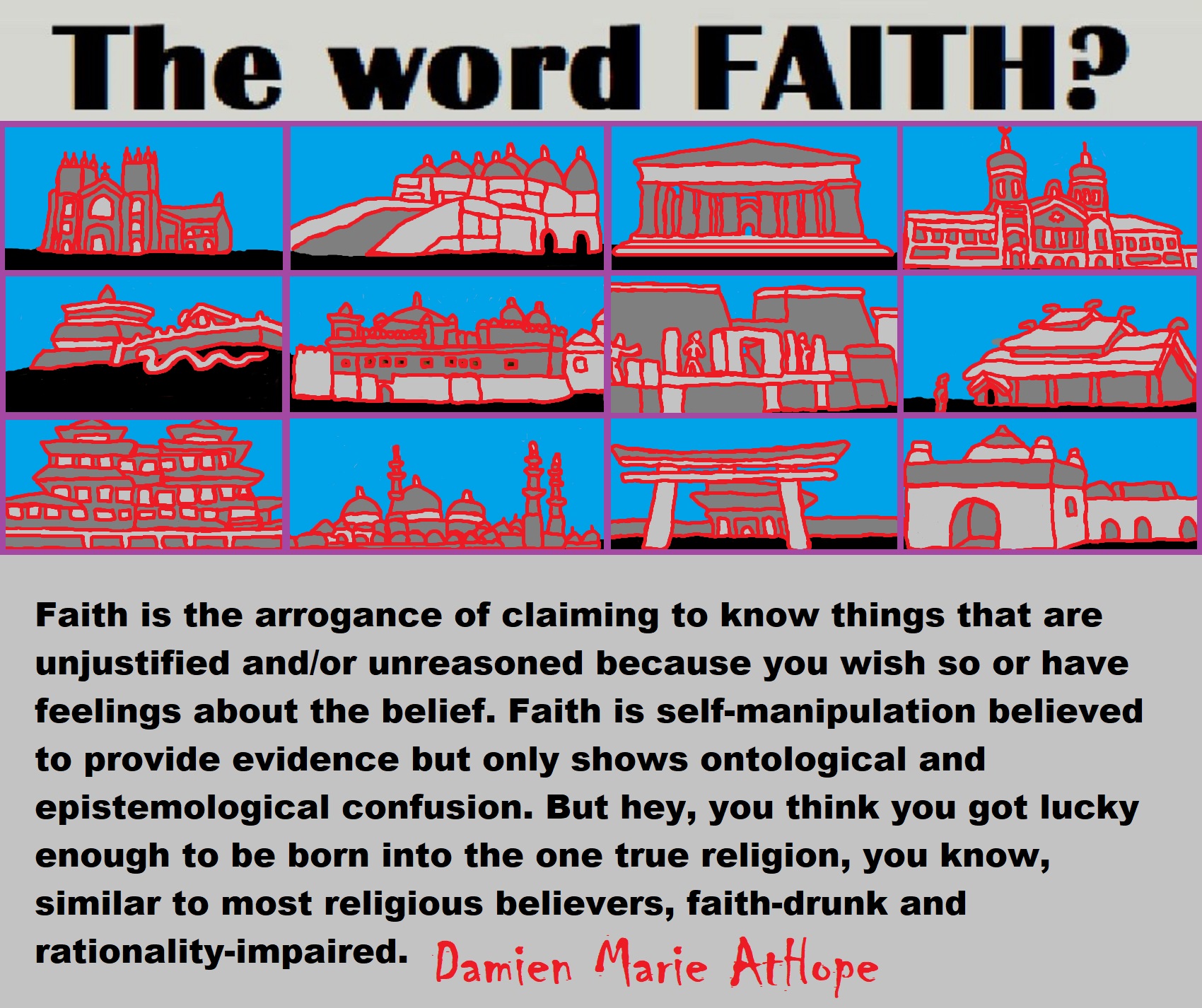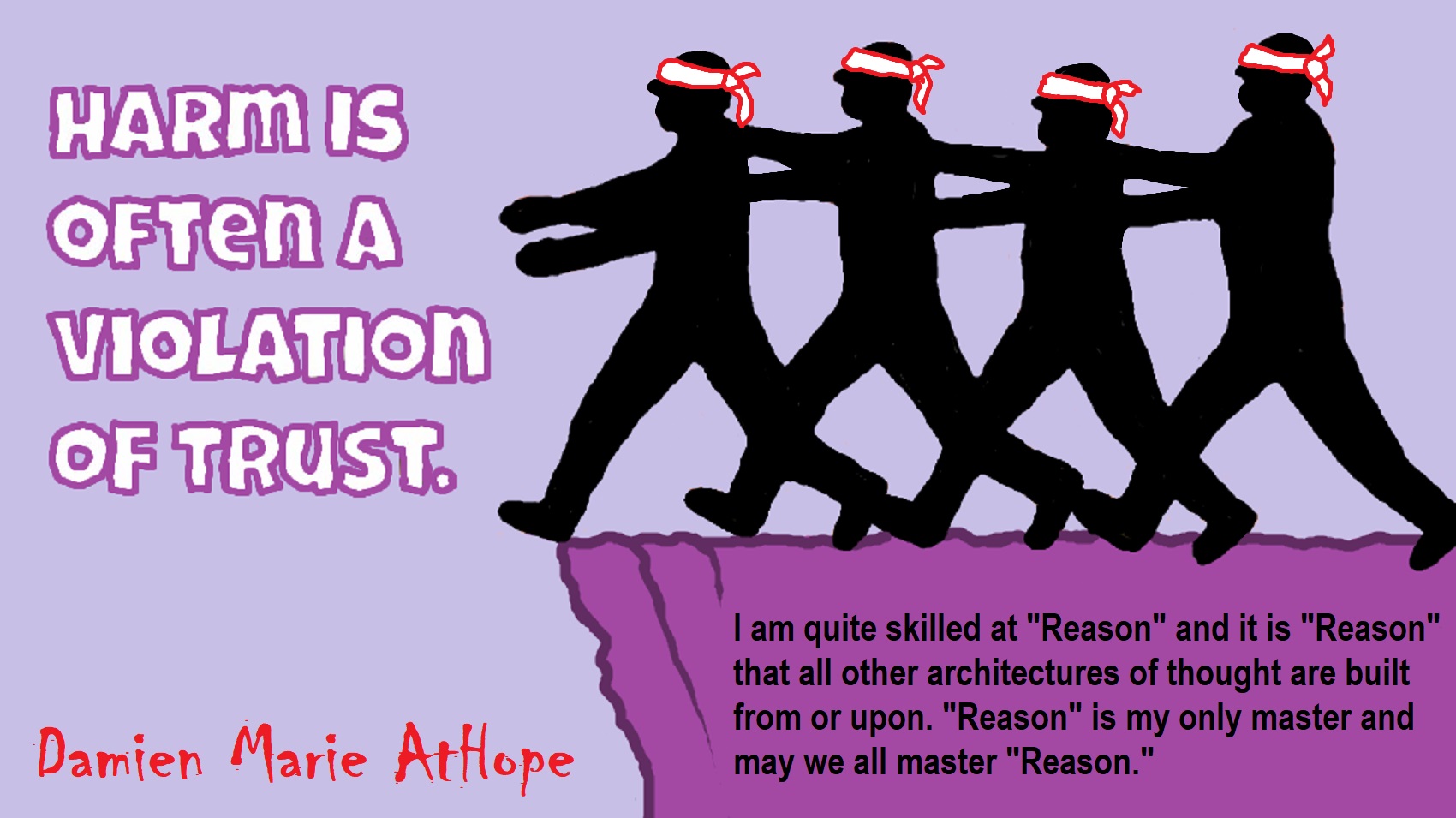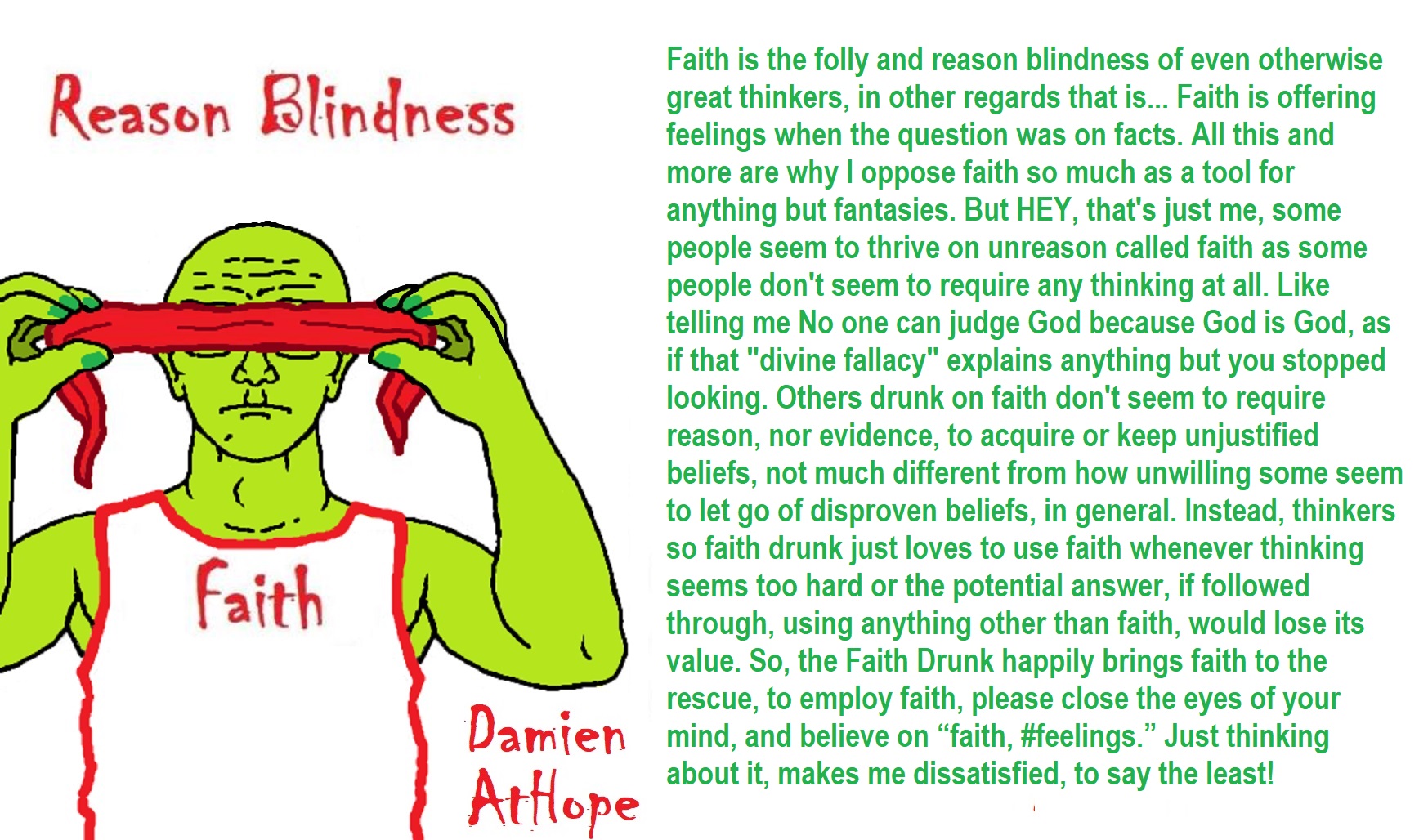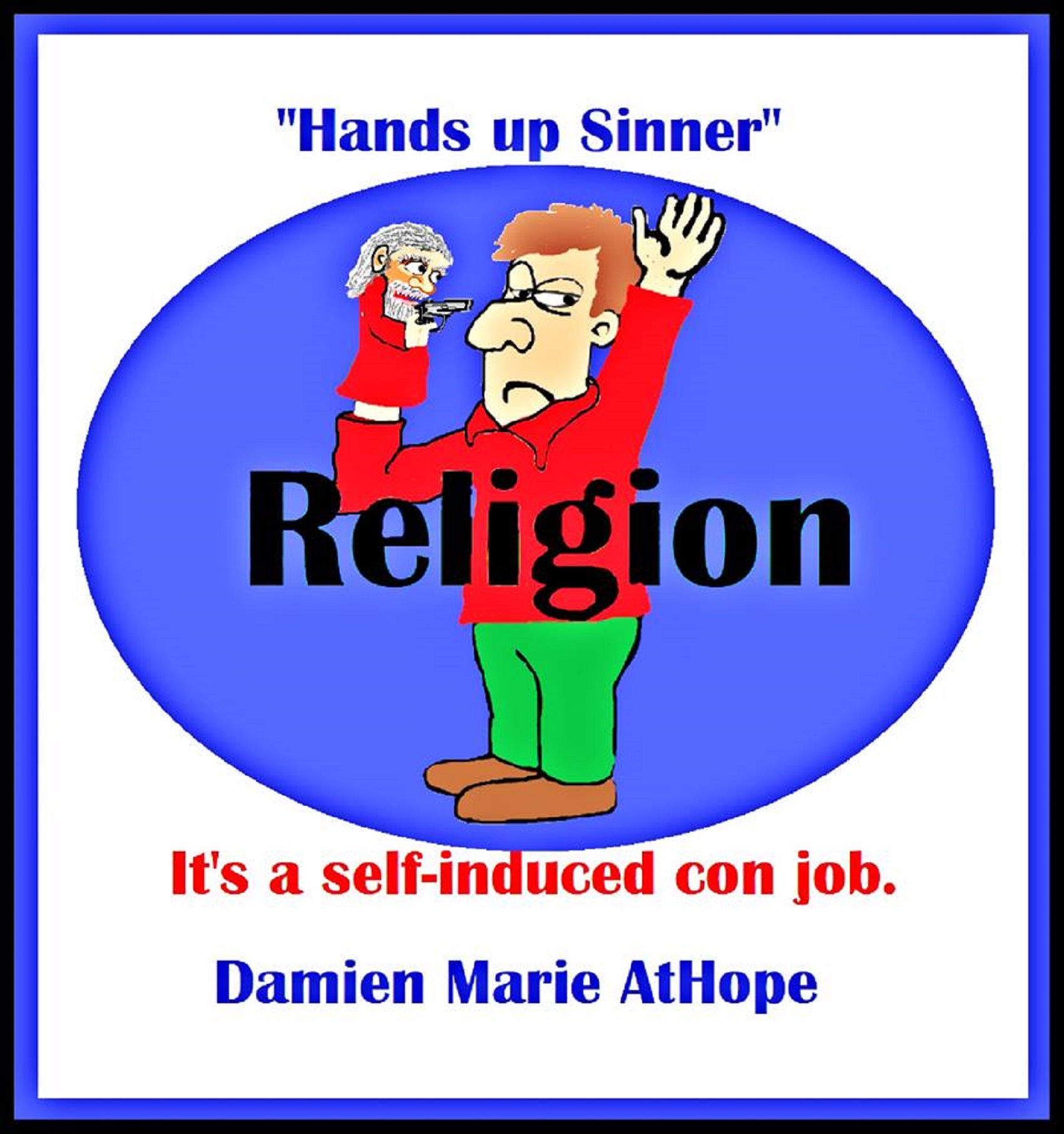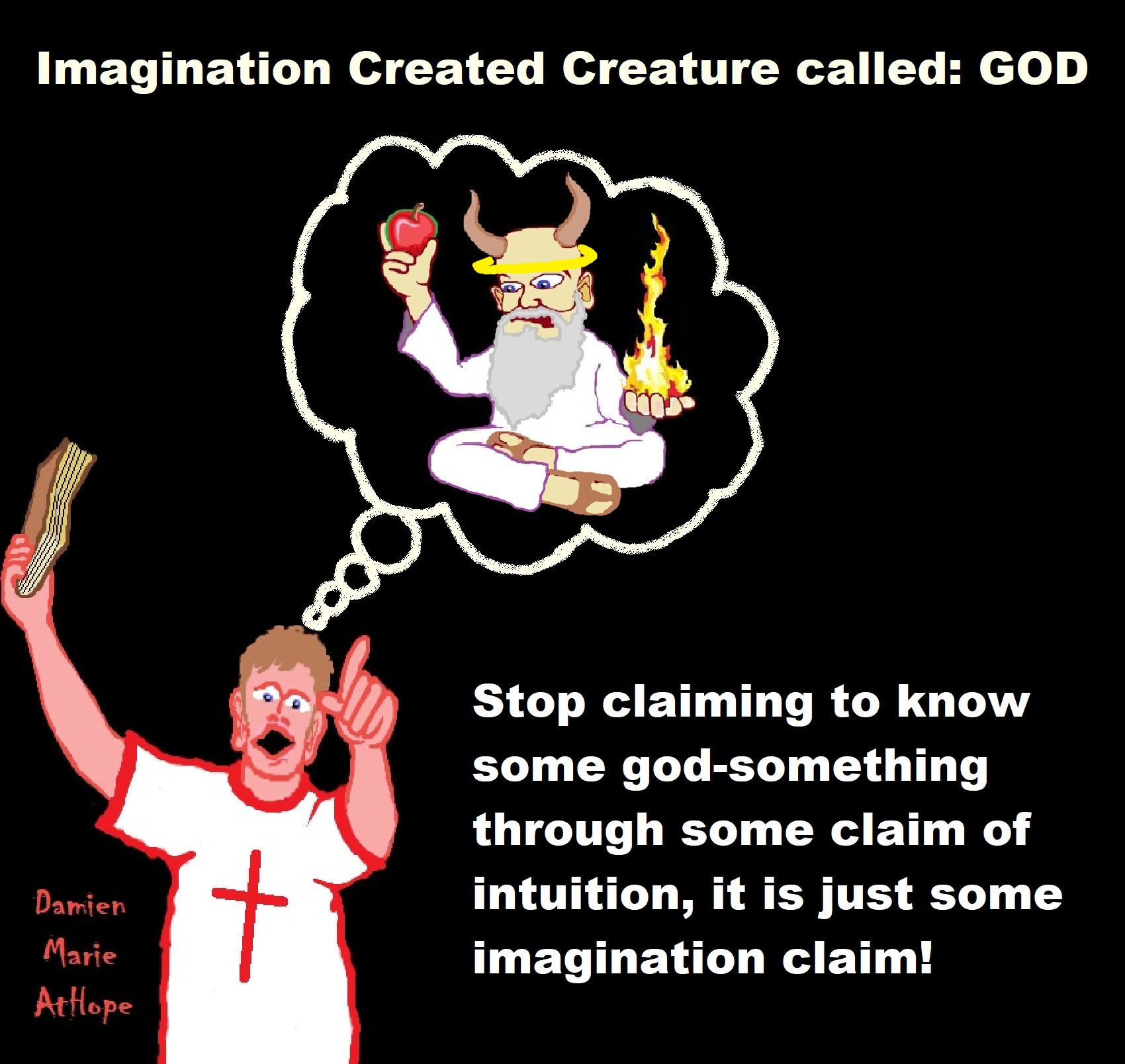
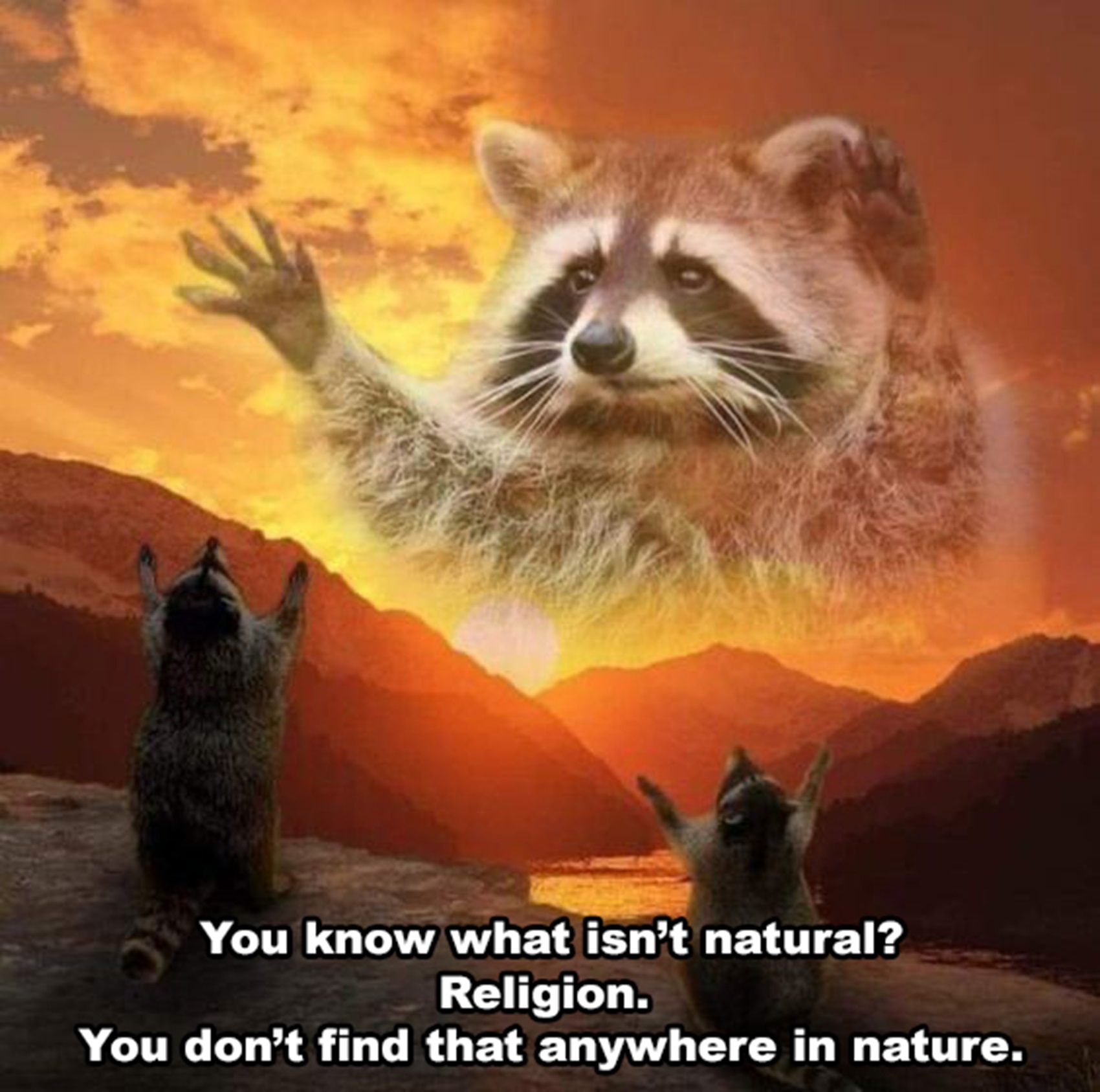
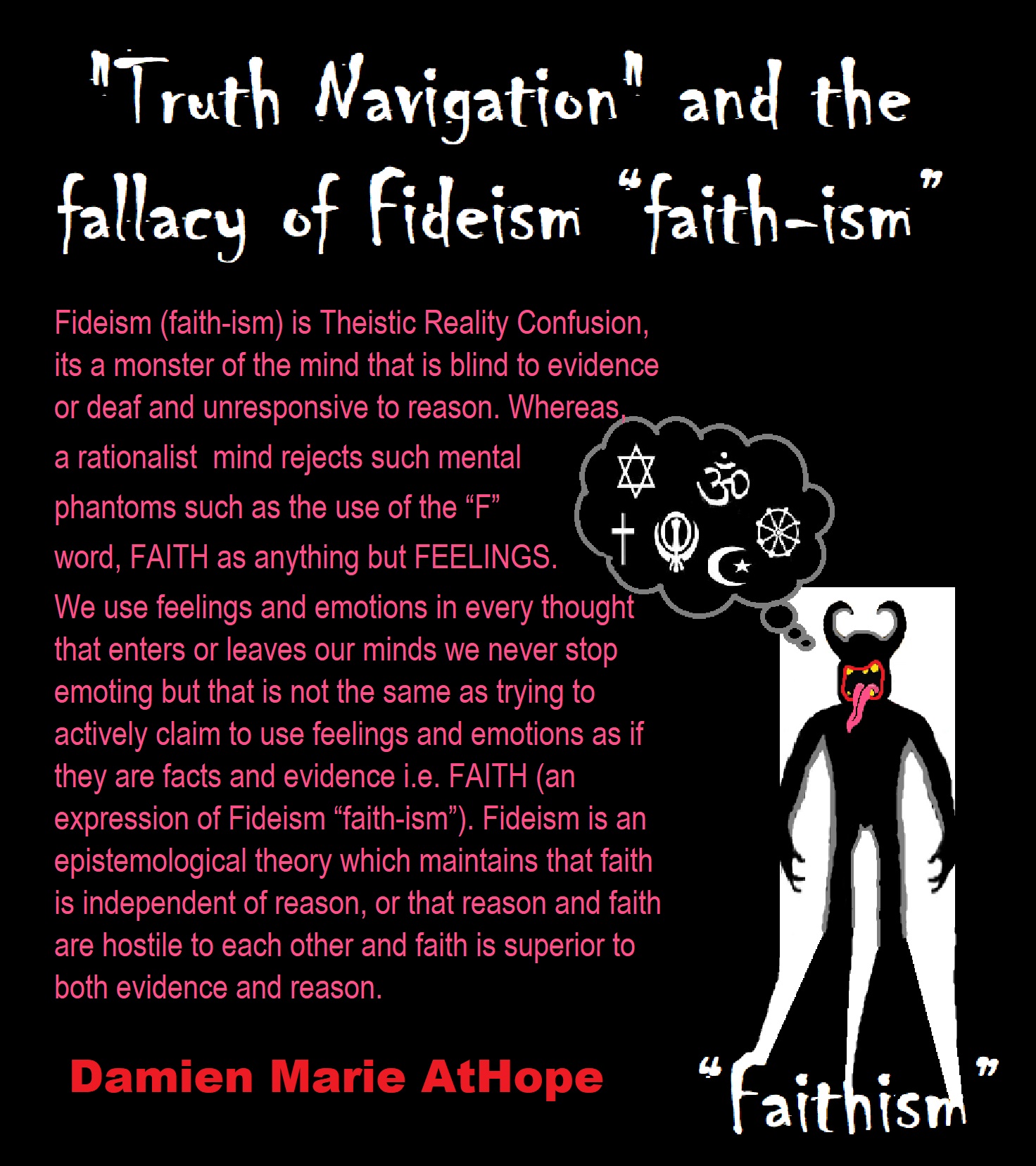
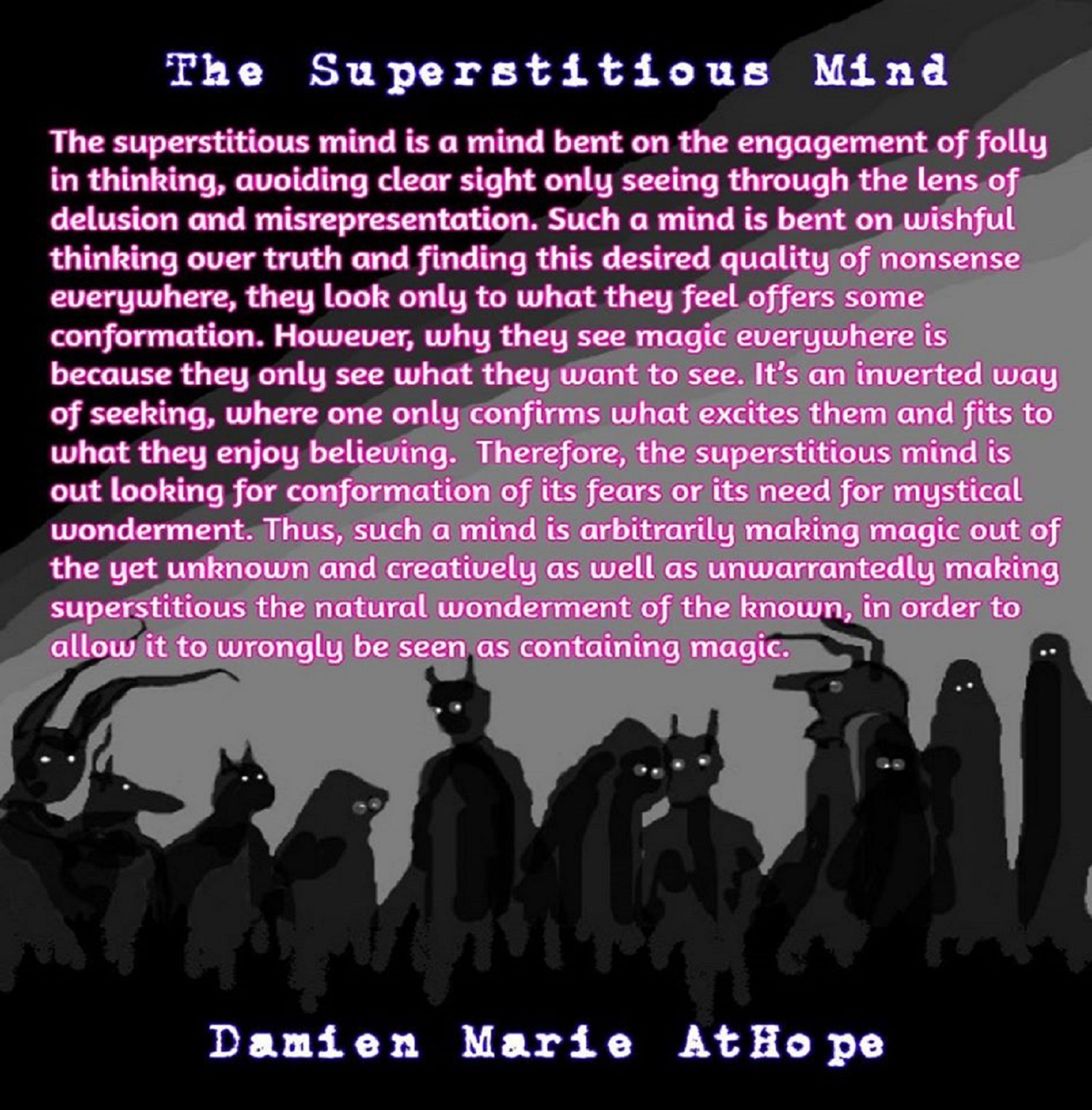
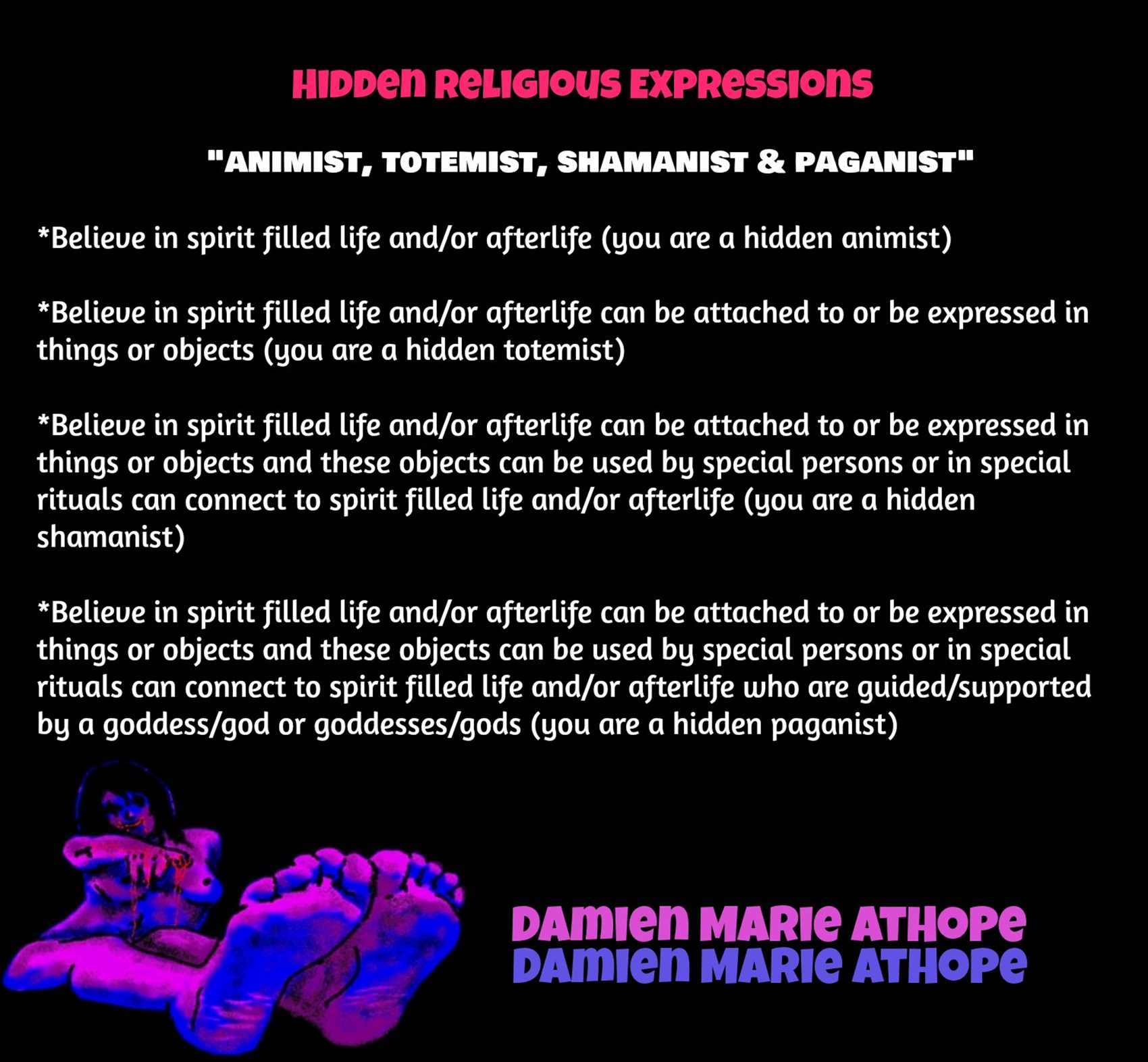



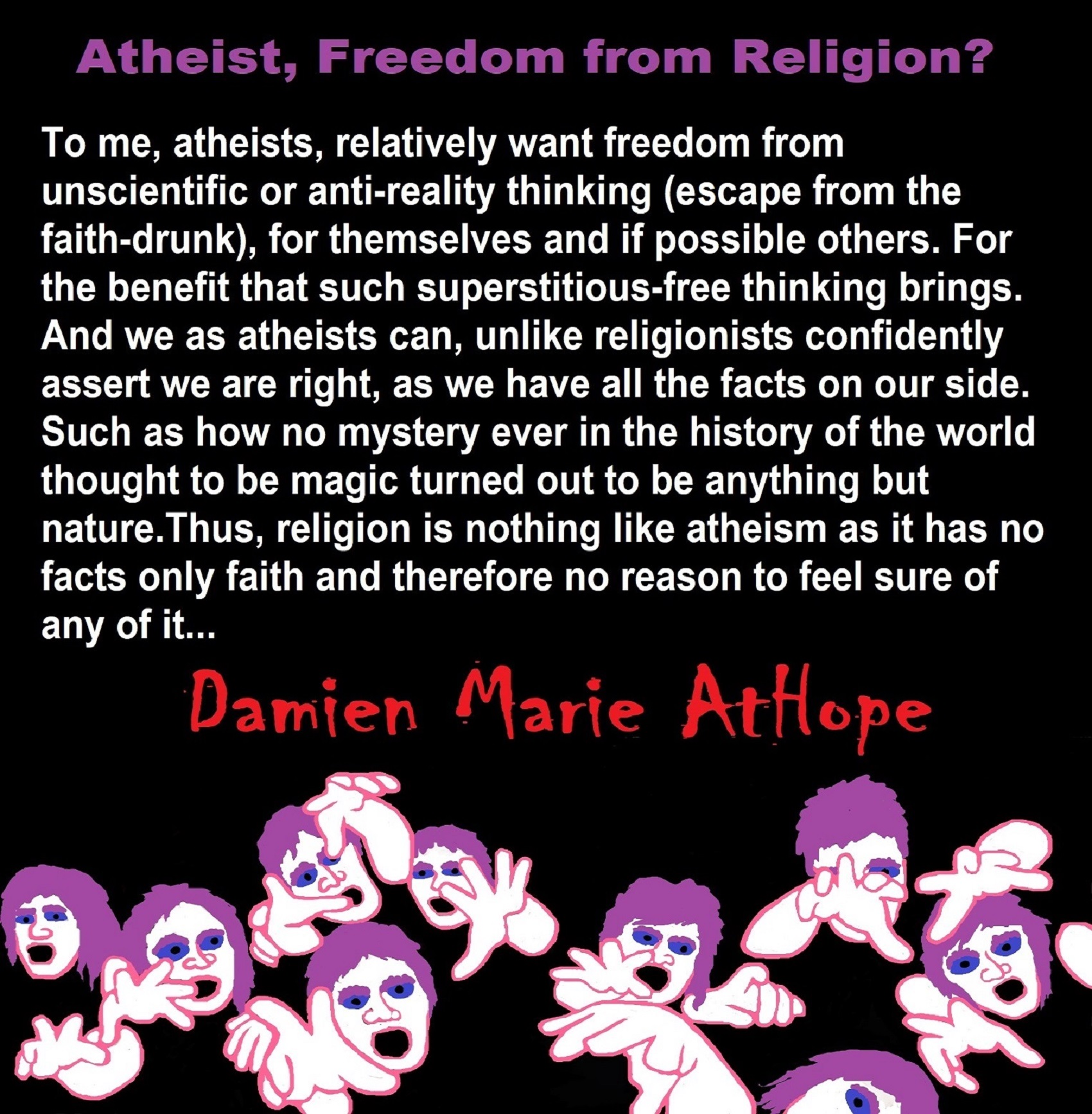
“But Damien, Souls are real because energy does not die!”
My response, That is a logical fallacy as it is not a reasoned jump in logic. Energy leaves all once alive bodies by dissipating heat in the environment then is gone as the once related energy in a now dead body.
Near-Death, Experiences is Brain Activity, not Supernatural
As before many times, here is yet, more evidence that near-death experiences are related to brain activity, not the supernatural. Many think they leave their body and up above their body can look down on things and thus say this is proof of life outside of death. But this is just more wishful thinking as always. To date, six studies have tried some form of this method, mostly on cardiac-arrest patients, and all have failed to find an ironclad case of veridical perception. All involved placing some stimulus—a picture or a symbol on, say, a piece of paper or an electronic display—in a high location, visible only if you were floating near the ceiling. The research designers did their best to make sure that nobody—not the doctors or nurses, not the patient, and not whoever interviewed the patient afterward—would know what the stimulus was until after the interviews were over.
The Science of Near-Death-Experiences
Evidence Near-Death-Experiences are not Supernatural
Debunking both Positive (HEAVEN) and Negative (HELL) near death experiences.
Many think they leave their body and up above their body can look down on things and thus say this is proof of life outside of death. But this is just more wishful thinking as always. To date, six studies have tried some form of this method, mostly on cardiac-arrest patients, and all have failed to find an ironclad case of veridical perception. All involved placing some stimulus—a picture or a symbol on, say, a piece of paper or an electronic display—in a high location, visible only if you were floating near the ceiling. The research designers did their best to make sure that nobody—not the doctors or nurses, not the patient, and not whoever interviewed the patient afterward—would know what the stimulus was until after the interviews were over.
“Most scientists assume it will—that NDEs are nothing more than the product of spasms in a dying brain.” – The Science of Near-Death-Experiences
“It’s long been suspected that what we describe as near-death experiences (NDEs) may be related to processes in the brain that create a flurry of activity to produce the strange sensations. Those that survive the beginning of the shutdown process may tell about it as a religious or spiritual experience. Well, it’s certainly strange. New research supports the idea that it may be physiological, not supernatural.” – Evidence Near-Death-Experiences are not Supernatural
Are some cultures or demographics more prone to believe in the superstitious or in certain superstitions?
Anyone can fall for foolishness in thinking
but fear seems to be a strong motivator,
with correlations seeming to be expressed in relative statistics research of poverty and threats to life.
“Generally, poorer nations tend to be religious; wealthy less so, except for U.S.” ref
“According to Richard Wiseman on Debunking the Paranormal, We know that is the case from polls and surveys. As I said at the beginning, more people believe in this stuff in the US than in the UK. And when you go from the West to the East, the numbers tend to be very high. So something is going on culturally. There seems to be some kind of bedrock, something in our brains which tells us this stuff is true and we should believe it. But the exact form it takes is often molded in the culture. If you take sleep paralysis – and the idea that there is an incubus on your chest sucking the life out of you, paralyzing you – in some cultures that’s seen as an old hag coming into the room, in other cultures it’s an alien, in some it’s an evil spirit. The experience is the same, but the way it’s interpreted is very different from one culture to another. I get sleep paralysis myself. It can be terrifying, and I can easily imagine why some cultures explain it supernaturally. It is a very scary experience. You can’t move and you may find it difficult to breathe. That alone is terrifying. But once you understand the science of it, it is less scary than thinking there are spirits on you.” ref
“The many experiences described by survivors of cardiac arrest — people revived even after their hearts stopped beating, sometimes for many minutes — include moving through a tunnel toward a white light, greeting relatives no longer alive, and overhearing conversations between family members in another room. A new study from the University of Michigan Medical School shows how the brain sends signals to the heart in the moments before death. It is this flurry of mental activity that is key to cardiac demise, the researchers say, and quite probably the foundation of near-death experiences as well.” – Near-Death Experiences May Be Explained By Heart-Brain Connection.
Dr. Jimo Borjigin explains that the reduction of oxygen during cardiac arrest can stimulate brain activity that may be interpreted as what we call an NDE. The paper was in the Proceedings of the National Academy of Sciences: Asphyxia-activated corticocardiac signaling accelerates onset of cardiac arrest: “The mechanism by which the healthy heart and brain die rapidly in the absence of oxygen is not well understood. We performed continuous electrocardiography and electroencephalography in rats undergoing experimental asphyxia and analyzed cortical release of core neurotransmitters, changes in brain and heart electrical activity, and brain-heart connectivity. Asphyxia stimulates a robust and sustained increase of functional and effective cortical connectivity, an immediate increase in cortical release of a large set of neurotransmitters, and a delayed activation of corticocardiac functional and effective connectivity that persists until the onset of ventricular fibrillation. Blocking the brain’s autonomic outflow significantly delayed terminal ventricular fibrillation and lengthened the duration of detectable cortical activities despite the continued absence of oxygen. These results demonstrate that asphyxia activates a brainstorm, which accelerates premature death of the heart and the brain.” Borjigin discovered that rats show an unexpected pattern of brain activity immediately after cardiac arrest. With neither breath nor heartbeats, these rodents were clinically dead but for at least 30 seconds, their brains showed several signals of conscious thought, and strong signals to boot. This suggests that our final journey into permanent unconsciousness may actually involve a brief state of heightened consciousness. Although the experiments were done in rats, Borjigin thinks they have implications for the near-death experiences (NDEs) reported by one in five people who are resuscitated after their hearts stop. Although they were unconscious, unresponsive and clinically dead at the time, they come back with stories of bright lights, “realer than real” memories, and meetings with people they knew. Some scientists have dismissed these accounts outright. Others have taken NDEs as proof of a religious afterlife or a consciousness that lives on outside the body, as popularised in a recent bestseller of dubious provenance. But Borjigin’s research suggests that these experiences could just be a natural product of a dying brain. That doesn’t make them any less real, but it does root them in the natural world, without the need for a “super-“ prefix. “The near-death experience might be considered a “final frontier” of consciousness studies,” says George Mashour, an anaesthesiologist from the University of Michigan and a co-author on the study. “It has been repeatedly proposed as a critical counter-example undermining the hypothesis that consciousness is rooted in the brain. Our study brings the phenomenon back into the realm of brain science.” ref
“The study was done in mice where they measured brain activity that turned out to be very active during the early stages of death. Scientists suspect that the same thing might happen in humans. The activity can create perceptions of a heightened state of consciousness. But, such a study on humans would be near impossible to do. It may be possible however to use this knowledge of the heart-brain connection in reverse and develop drugs that prevent full cardiac arrest.” – Evidence Near-Death-Experiences are not Supernatural
We are evolution, not some special creation. It is a flaw in reasoning to think that we evolved naturally and then somehow magically got some supernatural soul/spirit whatever. When in the evolution of humans do you think “magic” happened to make humans have a soul that could live after death anyway? Simply there is none, belief in souls or life after death is just wishful thinking. We are not magic filled nor are we that different than other primates….
In fact, the chimpanzee and human genomes are more than 98% identical, but there are a few short DNA sequences that have changed significantly in humans since the two species diverged about 5 million years ago. Most of the big differences between human and chimpanzee DNA lie in regions that do not code for genes, according to a new study. Instead, they may contain DNA sequences that control how gene-coding regions are activated and read. Most of the big differences between human and chimpanzee DNA lie in regions that do not code for genes, according to a new study. Instead, they may contain DNA sequences that control how gene-coding regions are activated and read. Comparing Chimp, Human DNA
“Having a near-death experience can change a person’s entire life, including one’s brain,
researchers have discovered. Researcher Willoughby Britton, studied the brain waves of people who have had positive, transformative near-death experiences and found their brain patterns distinctive when compared with people who didn’t have a brush with death. Britton compared the brainwaves of sleeping subjects and found a distinct spike in activity in the temporal lobe of people with near-death experiences. The brain’s temporal lobe has often been implicated in reports of near-death experiences that closely mirror what epileptics feel during a seizure: feelings of peace and tranquility, encountering a bright light and increased sensitivity to smells and sounds. It’s a profound personality overhaul. The temporal lobe, is considered the God module, the part of the brain that connects with the transcendent. Surprisingly, however, all of the activity that Britton recorded was from the left half of the brain, not the right half, which is more often associated with visual and spatial creativity. One hundred percent of the activity came from the left side, which, in itself, is very unusual. There’s no reason for someone to have an accident and just have one side of their brain affected. People’s brains may be predisposed to having transformative experiences, or, it is also plausible that near-death experiencers were indistinguishable neurophysiologically from other people before their [transformation], and that any observed changes reflect the transformative aftereffects of the experience. What is clear, however, is that all those in Britton’s study who came close to dying scored higher on an evaluation of their ability to cope with stressful situations than their counterparts. It’s more evidence that there’s no psychopathology in this group, which tends to be the scientific party line. In fact, people with positive transformative experiences tend to change in a way that a psychotherapist would want them to respond over a lifetime of therapy. They’re less self-centered, much more compassionate towards other people. Many people give up their jobs and become much more service-oriented” (Keller, 2004).
The reality of reality relates to an overwhelming agreement of among naturalist and realists’ thinkers utilizes Naturalistic and Realistic Ontology which the theory about the kinds of things that have existence. This thinking does not allow for the possibility of supernatural entities such as gods, goddess, devils, angels, heavens, or hells. These aspects are a proposition of the anti-real or beyond real and commonly called supernatural or super-reality which are disconnected with or from reality and not real. As nonbelievers, we claim this reality of reality on our side and are taking this call to follow and support the reality of reality out to an anti-real religious world.
A goal of science is “Truth” and “facts” what is the goal of Religion,
and more importantly is “Truth” and “facts” an important goal to you?
One of the strongest features of science is not that is finds “Truth” and “facts” but that it can correct flawed views of reality. Most people put a lot of faith into relying on religion, culture, or what they see as common sense and intuition, but faith is not a correct way to validate views of reality. Science helps us to understand the universe by freeing us from a reliance on gut-feelings or unchecked reasoning hopelessly rooted in the unsystematic software of our brains. Common sense, will never get us as far as we may wish (only sticking to what we think is true). Our preferences do not determine what’s true. Common sense does not have a strong features to correct flawed views of reality, it’s only criterion is the reject what is cannot comprehend or try to make new ideas fit in to look or be understood like old ides. The goal of science is to come as close as we can to understanding the cause-effect realities “Truth” and “facts” of the natural world. It’s never “truth” or “facts”. Scientific knowledge is not a collection of subjective opinions. Rather, it is a collection of explanations about objective reality that is based on observed or predicted phenomena “Truth” and “facts” or our best approximate truth until shown otherwise. In addition, the explanation must be verified repeatedly to confirm that it correctly models reality. Science is a practical approach that builds upon certain foundational principles that we assume to be true for our world which provides the best known method for arriving at the truth. As our technical ability to observe reality improves, we are able to increase the quality and quantity of our observations. Better-observed data challenge our explanations, some of which will no longer fit the observed facts. Science has proven itself able to provide the best estimates of the truth (i.e., what things are really like) based on evidence and processes which anyone given the time and willingness to learn can use to replicate/validate the estimates of truth generally accepted by the scientific community. If they are very good and very lucky, they may even create new estimates of truth not previously known or accepted today. Are there actual “truths” that the scientific process is not able to evaluate? Perhaps, but without a method for me to replicate/validate those truths, what good are they? I can say, for me, “They provide nothing good and tend to waste valuable time and human resources that could be better spent making our world a better place for us all.” New theories are then formed and either verified or falsified. While our scientific knowledge changes rapidly, the absolute reality that is being modeled has never changed. The scientific method assumes an absolute reality against which theories can be verified. Science does try to build true knowledge of how the world works, but there are other sorts of knowledge that people also call “the truth.” it’s important to remember that to be interested in scientific truth, one doesn’t have to reject other sources of meaning that can prove to be valid or reliable with reason and evidence. Science is a useful mythology that may not directly equal truth in all things it does equal error correction that makes scientific findings more likely to be true than unscientific superstitions or religious doctrines. Science is a method for getting a better and better understanding of reality over time. Religion is a method for rhetoric and dogmatic propaganda striving to remain unchanged and uncorrected staying locked in false beliefs never getting better and better understanding of reality over time but sticking to ever disproved nonreality. Religions are not even an approximation of truth and often enshrine their errors in dogma, uncorrected indefinitely. The scientific process, by contrast, may not protect us from erring initially, but it does protect us from erring forever. And that, to answer your question, is why we’re “more right” than religious believers. The issues here are complex and reach into technical areas of metaphysics and the philosophy of language. Some philosophers maintain that a correspondence theory of truth can be developed and defended without presupposing any absurd Archimedean point from which correspondences are instituted or detected. Others believe that it is a mistake to pursue any theory of truth at all. To assert that a given statement is true, they argue, is merely another way of asserting the statement itself. Fine elaborated this idea further in the context of the philosophy of science, proposing that one should accept neither realism nor antirealism; rather, one should give up talking about truth in connection with scientific hypotheses and adopt what he calls the “natural ontological attitude.” To adopt that attitude is simply to endorse the claims made by contemporary science without indulging in the unnecessary philosophical flourish of declaring them to be “true.”
The desire to hold magical thinking about consciousness is misguided Animism.
There is no reason to assert beyond idealistic or wishful thinking that one should conclude consciousness is anything but a product of our biological brains. A strong blow on the head shows how fast consciousness can be lost. Damage to the brain can change people’s personalities, mildly or completely. We can measure brain activity as a result of different stimuli.
The brain is amazing, but it is not magic.
But many still want to hold out that consciousness is something more, something magic or spiritual beyond the brain. That is not starting with facts and making reasoned hypothesis which is what one should strive for. That is starting with mystical is true and let me force it into any outcome as keeping my desired conclusions is important. On such an understanding I ask you if you believe in such mystical consciousness that is separate from the ordinary biological sciences of the brain that show otherwise, as I ask myself are you willing to change your thinking and stop seeing consciousness as anything more then a product of the brain? If you are willing to stick to facts (inference) over wild conjecture what level of facts do you need to see it this way, likewise think what level of facts did you truly employ to reach the brain disconnected consciousness hypothesis you seem to hold so strongly now? Just think did you put your current mystical seeming hypothesis to the same rigor you seem to put the non mystical evidence? If there is a difference and you critically think about it, why is this so and does this not inspire you to be open to the possibility of change? I will forever strive to be a truth seeker even if I have to let old ideas I love go for new ideas I enjoy less. We have brain damage studies that demonstrate consciousness is altered, hindered, or stopped depending on what part of our biological not spiritual or mystical. Severe acquired brain injury results in the dissolution of consciousness, providing a natural model from which key insights about consciousness may be drawn. ref
The ‘default network’ is defined as a set of areas, encompassing posterior-cingulate/precuneus, anterior cingulate/mesiofrontal cortex and temporo-parietal junctions, that show more activity at rest than during attention-demanding tasks. Connectivity in all default network areas was found to be negatively correlated with the degree of clinical consciousness impairment, ranging from healthy controls and locked-in syndrome to minimally conscious, vegetative then coma patients. Furthermore, precuneus connectivity was found to be significantly stronger in minimally conscious patients as compared with unconscious patients. Locked-in syndrome patient’s default network connectivity was not significantly different from controls. Our results show that default network connectivity is decreased in severely brain-damaged patients, in proportion to their degree of consciousness impairment. ref
Results, published in Brain in January 2012, suggested that “effective connectivity does correspond to the state of consciousness” in patients with brain disorders, said Pearce, and that the combined TMS/EEG approach is an effective way to measure consciousness in brain-damaged patients who cannot communicate with the outside world. ref
The body and the mind (as differentiated from things that have no mind i.e. rocks, plants, etc.) are products of evolution. And this is a view that really everyone should hold today as evolution is proven. We know that the mind (consciousness) is dependent on the activity of the brain, and we know that the brain is a product of evolution; thus, we know that the mind is a product of evolution. If the mind is not part of the brain when did this happen, how did this happen, and why did this happen from where did this happen are all required to be proven to even start to remove all the sureness of the same answers that evolution already answers showing both the body and the mind are products of evolution. If mind is not a product of the brain you are saying evolution is not the only explanation to life or that evolution is wrong, and evidence is quite the contrary. By looking at some of the core components of the human mind, they have clear links to survival and reproductive success: fear motivates the avoidance of danger; sexual desire motivates behaviors that lead to the production of babies; etc. The case that the mind is a product of evolution is strong. Evolutionary theory completely overthrows the view that the mind is not part of the brain. From an evolutionary perspective, it is impossible to maintain that the mind stands outside nature. Instead, it is a tiny fragment of nature, valued only by those tiny fragments of nature that possess it. Mind is not something separate from matter; it is a process embodied in matter. ref
To believe in the tangible doesn’t require faith, but to believe that the brain is a radio that can be damaged infers there’s a signal being produced for each individual on the planet that must emanate from some source. You can’t interject metaphysical esoteric philosophy in the gaps of science which is not just a rationale error to me it is a flagrant violation of epistemic humility you are taking as truth of things you do not know. Stop making things up. Science has identified chemical reactions in the brain with OUT OF BODY experiences and not one single case of OUT OF BODY travel has been reliably identified. Sorry to pop your bubble but no amount of LEARNED quoting will make it so. The study of consciousness remains philosophy for now. It has not bridged the “mystical” gap that you and many others have tried to bridge. One example that springs to mind is that program “What THe Bleep Do We Know”… Initially, it swayed my opinions but when I researched the SCIENCE behind each of the “actors” a completely different picture emerged. One cannot simply make stuff up without EVIDENCE, no matter what your credentials and LEARNING implies. Even if a few people believe something that does not make it fact that makes it belief. To say that beliefs consciousness of a few even in different fields still is not evidence, as the same can be said about the belief of a god. Beliefs do not creative evidence no matter how strong the beliefs are to think otherwise is a fallacy. The hypothesis that the brain creates consciousness, however, has vastly more evidence for it than the hypothesis that consciousness creates the brain. Damage to the fusiform gyrus of the temporal lobe, for example, causes face blindness, and stimulation of this same area causes people to see faces spontaneously. Stroke-caused damage to the visual cortex region called V1 leads to loss of conscious visual perception. Changes in conscious experience can be directly measured by functional MRI, electroencephalography and single-neuron recordings. Neuroscientists can predict human choices from brain-scanning activity before the subject is even consciously aware of the decisions made. Using brain scans alone, neuroscientists have even been able to reconstruct, on a computer screen, what someone is seeing. Thousands of experiments confirm the hypothesis that neurochemical processes produce subjective experiences. The fact that neuroscientists are not in agreement over which physicalist theory best accounts for mind does not mean that the hypothesis that consciousness creates matter holds equal standing. In defense, Chopra sent me a 2008 paper published in Mind and Matter by University of California, Irvine, cognitive scientist Donald D. Hoffman: Conscious Realism and the Mind-Body Problem. Conscious realism asserts that the objective world, i.e., the world whose existence does not depend on the perceptions of a particular observer, consists entirely of conscious agents. Consciousness is fundamental to the cosmos and gives rise to particles and fields. It is not a latecomer in the evolutionary history of the universe, arising from complex interactions of unconscious matter and fields, Hoffman writes. Consciousness is first; matter and fields depend on it for their very existence. Where is the evidence for consciousness being fundamental to the cosmos? Here Hoffman turns to how human observers construct the visual shapes, colors, textures and motions of objects. Our senses do not construct an approximation of physical reality in our brain, he argues, but instead operate more like a graphical user interface system that bears little to no resemblance to what actually goes on inside the computer. In Hoffman’s view, our senses operate to construct reality, not to reconstruct it. Further, it does not require the hypothesis of independently existing physical objects. How does consciousness cause matter to materialize? We are not told. Where (and how) did consciousness exist before there was matter? We are left wondering. As far as I can tell, all the evidence points in the direction of brains causing mind, but no evidence indicates reverse causality. This whole line of reasoning, in fact, seems to be based on something akin to a God of the gaps argument, where physicalist gaps are filled with nonphysicalist agents, be they omniscient deities or conscious agents. ref
Reincarnation beliefs among near-death experiencers.
“Several researchers have found that near-death experiences (NDEs) tend to increase belief in reincarnation. This study examined factors underlying this belief shift. The author used a questionnaire to compare the tendency toward belief in reincarnation among 43 near death experiencers (NDERs), 34 individuals merely interested in NDEs, and 30 nonexperiencer, noninterest controls. In addition, 14 NDERs were interviewed to gain insight into factors influencing NDERs’ beliefs. NDERs’ reincarnation belief shift appeared to be due to (1) direct knowledge of reincarnation gained by some NDERs in the NDE itself, (2) knowledge of reincarnation gained through a general psychic awakening following the NDE, or (3) exploration of alternative perceptions of reality following the NDE.” ref
Ghosts on the Brain
“Sleep states and altered states of consciousness can lead people to believe that they have experienced something supernatural. For example, skeptics have used sleep paralysis or a hypnogogic trance to explain encounters in which people see spirits while in bed and are unable to move or escape. Most people experience a hypnogogic trance once or twice in their lives, although it is far more common in people with epilepsy or certain sleep disorders.” ref
“According to a 2005 Gallup poll, more than a third of Americans believe that houses can be haunted, and about 32 percent believe specifically in ghosts [Source: The Gallup Poll News Service]. Morover, according to believers, a ghost is the spirit of a dead person that either has not moved on to the afterlife or has returned from it. The definition of “spirit” can vary. Some describe it as a person’s soul, while others believe it is an energetic imprint that a person leaves on the world. Humans have believed in — or been skeptical about — ghosts for thousands of years. They’re even mentioned in the oldest known written work of literature, “The Epic of Gilgamesh.” Ghost stories are part of most cultures’ folklore, although the details vary considerably from region to region. In the next section, we’ll take a closer look at ghostly encounters.” ref
Does the soul weigh 21 grams?
“That is where the movie title comes from. This was an American psychologist around the turn of the 20th century who put dogs onto scales, trying to weigh their souls leaving. He had some success with that, then tried the same with humans – putting very old people on the scales and waiting for them to die. But what he didn’t control for is sweating, moisture leaving the body. So 21 grams is probably much closer to the amount of moisture you lose when you die than your soul.” ref
What exactly is a near-death experience?
“A near-death experience is very similar to an out-of-body experience, which is where people think they’re floating away from their body, turned around seeing their body lying there. In a near-death experience, there is often a tunnel of light you go down towards meeting your maker. The gods you see depend very much on the culture you live in. Then the god turns you back, you return into your body and you wake up. As we know more about how the brain creates a sense of where it is, we know more about how these experiences can be created. Now there are experiments where we can create an out-of-body experience fairly rapidly. Other researchers – and Mary Roach talks about these – write target numbers or words on pieces of cardboard and place them on top of cabinets and wardrobes in hospital wards, in the hope that somebody having a near-death or out-of-body experience will look down and see them. To date, they haven’t. Which again suggests that this is an illusion rather than a genuine experience.” ref
So let’s look at if peoples negative near-death experiences prove Hell?
The quick answer is hell no! Sorry, it’s not true believers you only get this one life. As with the pleasurable near-death experiences, distressing or negative near-death experiences seem to occur about equally to people of both genders and of all ages, educational levels, socioeconomic levels, sexual orientations, spiritual beliefs, religious affiliations, and life experiences. The estimated incidence of distressing near-death experiences has ranged from 1% to 15% of all near-death experiences (Bonenfant, 2001). Although people have sometimes wondered whether “good people” what religionists like to call themselves; no matter how they live there life, somehow as the unholy books of myths say are due to have pleasurable experiences in the afterlife. And us “bad people” what religionists like to call “everyone, not them,” have what they hope are distressing or negative experiences in the afterlife. But distressing or negative near-death experiences still provide hell to be their wishful bullshit as always. Sorry, again believers research has shown no such relationship between apparent life deeds and type of NDE (Rommer, 2000). So even negative near-death experiences can be thought to tell us anything it still sounds like no god so you being an atheist is still sound friends. In addition, some people’s NDEs have contained both pleasurable and distressing elements, and among people who have had multiple NDEs, some have had a pleasurable experience one time and a distressing experience another, in no definite order. The way one dies may be a true factor in the type of near-death experiences one has sounds more like not god. Again research found that distressing near-death experiencers who had self-induced their deaths made up 55% of people in her research who reported a Type II Eternal Void experience, 18% who reported a Type III Hellish experience, and most of those who reported a Type IV Negative Judgment experience. Although it may be tempting to conclude that people who attempt suicide are being punished for trying to induce their own deaths, we must avoid this temptation, as the following paragraph will explain. Greyson and Bush (1996) classified reports of distressing near-death experiences into three types:
- The most common type included the same features as the pleasurable type such as an out-of-body experience and rapid movement through a tunnel or void toward a light but the near-death experiencer, usually because of feeling out of control of what was happening, experienced the features as frightening.
- The second, less common type included an acute awareness of nonexistence or of being completely alone forever in an absolute void. Sometimes the person received a totally convincing message that the real world including themselves never really existed.
- The third and rarest type included hellish imagery such as an ugly or foreboding landscape; demonic beings; loud, annoying noises; frightening animals; and other beings in extreme distress. Only rarely have such near-death experiencers themselves felt personally tormented.
The research found that distressing near-death experiencers who had self-induced their deaths are people who are in a distressed frame of mind at the time of their near-death episode and those who were raised to expect distress during death may be more prone to distressing near-death experiences. Sounds more like ghosts not god right? People who attempt suicide are almost always in a distressed frame of mind. Usually, they are attempting suicide because they feel themselves to be in unendurable and unending emotional or physical pain. In addition, they are almost certainly aware of the widely held belief that suicide is cowardly and/or the wrong way to escape the pain of life. Although they hope for relief from their pain, they may also consciously or unconsciously fear punishment. In a heightened state of pain, as well as of fear and/or guilt, they are highly distressed and, consequently, may be somewhat more prone to having a distressing near-death experience. Proving as always even a negative near-death experience is still not a proof of a religious Hell, in fact, it dispels it. ref
In its Science and Engineering Indicators report, the National Science Board (NSB) asserts that belief in the paranormal can be dangerous. According to the NSB, belief in the paranormal is a sign of reduced critical thinking skills and a reduced ability to make day-to-day decisions. However, since it’s virtually impossible to prove that something does not exist, people will probably continue to believe in ghosts and haunted houses, especially since unexplained events aren’t likely to go away anytime soon. ref
“Dead is Dead” no ghosts, spirits or souls…
“Dead is Dead” no ghosts, spirits or souls… What Part of That confuses you?
Think ghosts are proven real? You may say the ghost hunting shows prove it to you, OK, you may need to rethink what standard you put on proof. Think does this belief in ghosts involve a fear ghosts? We are all good people don’t die from ghosts for the same reason the jolly green giant is not some farming tyrant, simply understood, neither exists in reality. What evidence do I have for this non-harm? Well, why not use the same very ghost hunting shows continuing to go year after year never having a member killed should be proof enough not to worry, i.e. “YOU” start to get that it’s just adults playing make-believe.
“A Physicist Just Explained Why the Large Hadron Collider Disproves the Existence of Ghosts“
According to sciencealert.com, “Recent polls have found that 42 percent of Americans and 52 percent of people in the UK believe in ghosts – a huge percentage when you consider that no one has ever come up with irrefutable proof that they even exist. But we might have had proof that they don’t exist all along, because as British theoretical physicist Brian Cox recently pointed out, there’s no room in the Standard Model of Physics for a substance or medium that can carry on our information after death, and yet go undetected in the Large Hadron Collider. “If we want some sort of pattern that carries information about our living cells to persist, then we must specify precisely what medium carries that pattern, and how it interacts with the matter particles out of which our bodies are made,” Cox, from the University of Manchester, explained in a recent episode of BBC’s The Infinite Monkey Cage. “We must, in other words, invent an extension to the Standard Model of Particle Physics that has escaped detection at the Large Hadron Collider. That’s almost inconceivable at the energy scales typical of the particle interactions in our bodies.” Astrophysicist Neil deGrasse Tyson, who was also on the show, replied, “If I understand what you just declared, you just asserted that CERN, the European Centre for Nuclear Research, disproved the existence of ghosts.” “Yes,” said Cox. It’s become glaringly obvious that the Standard Model of Physics is an incomplete theory, with several gaping holes that physicists have been trying to patch up for decades, but Cox says the existence of ghosts doesn’t fall within the ‘known unknowns’ of the Standard Model. Instead, he says it directly contradicts the one of the most rigorously tested and fundamental laws of the Universe we have – the second law of thermodynamics. The second law of thermodynamics states that the total entropy of an isolated system always increases over time. Entropy is a measure of the randomness or disorder within a closed or isolated system, and the second law of thermodynamics states that as usable energy is lost, chaos increases – and without extra energy being put into a system, that progression towards disorder can never be reversed. In other words, energy is always lost to heat in any system – whether it’s a washing machine or the Universe – and you can never get back all the energy you put in. The principle can be used to explain why the arrow of time only ever marches forwards; why there’s a past, future, and present; and why you can’t un-scramble an egg, because it would lower the Universe’s entropy. So how does that apply to ghosts? Because we can’t touch and interact with them, ghosts can’t be made of matter, but instead of energy. And if energy is necessarily lost within every system – particularly if they’re doing anything that requires using more of it, such as moving, emitting light, or making spooky sounds – it would be impossible for them to maintain their existence for any significant period of time. The second nail in the coffin comes from the Large Hadron Collider, because while there are things about the Universe we still can’t find using this giant particle accelerator, what we can see very well is the way energy drives our cells’ information. If we assume that the energy that sustains ghosts isn’t an entirely new substance or medium, but carries on from when we were living, then this mysterious force controlling the particles that make up our cells would have been detected in the Large Hadron Collider by now. “I would say if there’s some kind of substance that’s driving our bodies, making my arms move and legs move, then it must interact with the particles out of which our bodies are made,” says Cox. “And seeing as we’ve made high precision measurements of the ways that particles interact, then my assertion is that there can be no such thing as an energy source that’s driving our bodies.” DeGrasse Tyson adds to this by saying that while he, like many people, has experienced “haunting experiences” in the past, he’s yet to really find a phenomenon that’s defied his complete knowledge of physics, maths, and astrophysics. But that doesn’t mean he doesn’t get the very human urge to want to believe in the lingering dead. “In that moment, there’s a mystery, and it’s kinda fun,” he says. “And that allows me to understand, and even embrace, the urge that people have to want there to be this deep mystery, such as ghosts of ancestors. I have a soft spot for what that psychological state is, because I’ve felt that intermittently, except I kept exploring and getting the answer.” You can download and listen to the whole segment at the BBC’s website.” Ref
So are Ghosts Possible, Because Energy Does not Die? Well, NO!
No ghosts are not possible, as at no time did magic get added to our natural evolution.
However, ghost believers say but it’s not magic, its reality, it’s a scientific fact that once energy is created, it can never cease to exist, it just changes form. Nevertheless, they are in error, they seem to be confusing two things, as energy is mindless, not aware of what it was in a previous form. Science is against ghosts and souls and stating that energy can go on is a non-sequitur to infer that proves ghosts is like saying that because we were once star stuff we turn back into stars. Ghost believers will most likely keep believing and close in on the belief while also closing out the reason and evidence debunking the belief in ghosts. They can believe as they wish and no amount of that belief makes a thing such as ghosts true. Let’s address the thinking that if energy cannot be created or destroyed but only change form, what happens to our body’s energy when we die, why not ghosts?
According to Benjamin Radford, a Live Science Contributor, it may seem like a reasonable assumption — unless you understand basic physics. The answer is very simple, and not at all mysterious. After a person dies, the energy in his or her body goes where all organisms’ energy goes after death: into the environment. The energy is released in the form of heat, and transferred into the animals that eat us (i.e., wild animals if we are left unburied, or worms and bacteria if we are interred), and the plants that absorb us. There is no bodily “energy” that survives death to be detected or seen. So are ghosts real? Science says NO. Ref
You still believe in ghosts because you think you have seen or felt them? Well think again it’s all just in your head.
Scientists Created “Ghosts” in the Lab: This sensation is commonly reported in people with certain neurological or psychiatric disorders, or those exposed to extreme conditions. In 1970, mountaineer Reinhold Messner reported seeing a “phantom” climber descending the slopes of a particularly extreme summit alongside him. This also happens in people who have recently experienced another extreme condition: the loss of a spouse. In most cases, the sufferer reports the very real sensation of an unseen presence. This is the stuff of which ghost stories are made, but researchers say they know why this feeling occurs, and they’ve even recreated it in the lab. Ref
Scientific Thinking not Faith Thinking
Science, unlike faith, uses more Critically Open-Minded Reasoning (open assessment and reflective correctability) the effort to overcome all of those issues common with Induced Delusional Disorder or “faith brainwashed” thinking. With science, unlike faith thinking, all facts are welcomed, even if they contradict a treasured theory or model, which must then be rejected immediately. A true scientist will be delighted at having found a new aspect of science, especially if it changes a scientific view, whereas a true religionist/fideist motivated by faith or Induced Delusional Disorder will deny it and try to explain it away. Admittedly science is not a single category, approach or thinking, however, nobody who is reasonable and informed can or should reject or deny the truths it produces. Religion too is not a single category, approach or thinking, however, nobody who is reasonable and informed can accept its deluded or reality devoid beliefs as any kind of truths. The scientific method assumes a priori of methodological naturalism about the nature of reality that is devoid of considering supernatural causes, it is not agnostic about this. The scientific method is using a form of philosophical rationalism to establish this view about the nature of reality along with the commonly held philosophy of empiricism, because looking for proof or truth devoid of considering supernatural causes by using a priori assumptions is employing rationalism. Open–mindedness for Bertrand Russell is the virtue that prevents habit and desire from making us unable or unwilling to entertain the idea that earlier beliefs may have to be revised or abandoned; its main value lies in challenging the fanaticism that comes from a conviction that our views are absolutely certain. A review of certain key ideas provides a clearer sense of the dimensions of the ideal of open-mindedness for all those who are determined to make this aim central to their work as teachers. What follows is a roadmap to the terrain which surrounds the idea of open-minded inquiry. Ref Moreover, Open-mindedness is receptiveness to new ideas. Open-mindedness relates to the way in which people approach the views and knowledge of others, and “incorporate the beliefs that others should be free to express their views and that the value of others’ knowledge should be recognized.” According to What Makes Your Brain Happy and Why You Should Do the Opposite, closed-mindedness, or an unwillingness to consider new ideas, can result from the brain’s natural dislike for ambiguity. According to this view, the brain has a “search and destroy” relationship with ambiguity and evidence contradictory to people’s current beliefs tends to make them uncomfortable by introducing such ambiguity. Research confirms that belief-discrepant-closed-minded persons have less tolerance for cognitive inconsistency. Ref
Spiritual Woo Woo, Trying to Make Magic of Reality.
I was asked what are my Thoughts on Spirituality?
I Blaspheme the Unreal Unholy Bible Spirit called gOD
A person to me: Damien, I’m with you on the science side and nature. But what are your thoughts on spirituality?
My response: Personally I don’t know what that means. I use to call myself a spiritual atheist but the more I learned the less I saw that as anything meaningful and was just my placeholder carry over word from my religious past. What I meant by it was I say value and meandering in the world. That thingswhere connected in some way. I now have a nonreligious word that states this and is more substantive and beneficially descriptive. Axiology or Axiological. Which stands for value theory or value science. And I call myself an Axiological Atheist. But its more than just that value is also a morality and humanistic motivation for my atheism.
A person to me: Pretty good. Maybe spirituality is just being conscious of morals and reality. Just wondered where you stood on it. I still pray. (learned behavior I guess). Thanks for the reply.
My response: I believe in you and you should believe in you.
A person to me: Right on, thanks.
My response: I can send you a link about Axiological Atheism if you want.
A person to me: Alright cool.
My response: Axiological Atheism Explained, Explaining Axiological theism, Axiological agnosticism, and Axiological atheism, Axiological Dignity Being Theory
Overall it should be understood that I don’t value the word spiritual.
It really means nothing to me. I went through a faze when I was working through understanding myself apart from religion I had lived my whole life. So, I use to say I was a spiritual atheist. That for me was lack of understanding how to use nonreligious words to explain how I felt. With the word spiritual, I wanted to say I saw meaning in the world, which people had value and I cared and wanted to live an ethical humanistic life. I now do not put value in the word spiritual as it has 20 meanings if you ask 10 people. Use of the word spiritual to me is just woo-woo, trying to making magic of reality. I have a better word that is more accurate to my thinking “axiological/axiology especially formal or scientific axiology and this word does not have the religion baggage. I am an Axiological Atheist (value theorist atheist). Axiological to Atheist: is meant to denote an atheistic rejection of the existence of gods or supreme beings in favor of a “higher absolute”, such as humanity or universal ethical principles. Axiological reasoning as a form of atheism mindset favors humanity as the absolute source of holistic ethics and care values and permits individuals to resolve moral problems without resorting to gOD. One value of holistic universal ethics being humanistic is mutual care and responsibility. In the absence of a supernatural caretaker, we know that the responsibility for improving this world rests where it always has – with the people who live, think, feel, and act in that world. Thus, no spiritual woo-woo needed or wanted. If you think spiritual is true because you think that we have a soul or spirit check out: “My correspondence with a believer in souls” If you think spiritual is true because you think that ghosts or spirits are true check out: “So are Ghosts Possible, Because Energy Does not Die? Well, NO!” If you think spiritual is true because you think developed a spirit in evolution check out: If you think spiritual is true because you think humans have a spirit, because we may not be part of evolution check out: “Humans are Part of Evolution not a Special Creation” and Evolution is FACT!
Two Atheists philosophers: debate “spiritual”
To me, the term spiritual is a lingering connection to religious beliefs and Science Facts Should Make Religious Belief Impossible. Wondering why I am so harsh on woo woo ideas like spiritual and not just attack or challenge religion, well I Hate Religion Just as I Hate Pseudoscience.
Extreme Religious Faith & Induced/Shared Delusional Disorder
Why we know religions and gds are lies is confirmed in my blog, “The Evolution of Religion and Removing the Rationale of Faith”
The Way of a Sound Thinker?
Battle For Evidence?
Why do most religious people claim to have religious or spiritual experiences is they add make-believe to “reality”, and the general “WHY” to me is because we are emotional beings that while we can employ the thinking strategy of rationalism over faith or unreason/illogical beliefs that follow we still appeal to emotionalism, not the other way around as we are not rational beings who understand the world accurately by employing the thinking strategy of emotionalism over faith or unreason/illogical beliefs that follow, right? We are all emotional and experience emotional wonder but that is just the joy of being alive, it’s wholly cheapened to me by fantasy daydreaming delusions (supernatural) to this wonderful magic devoid reality.
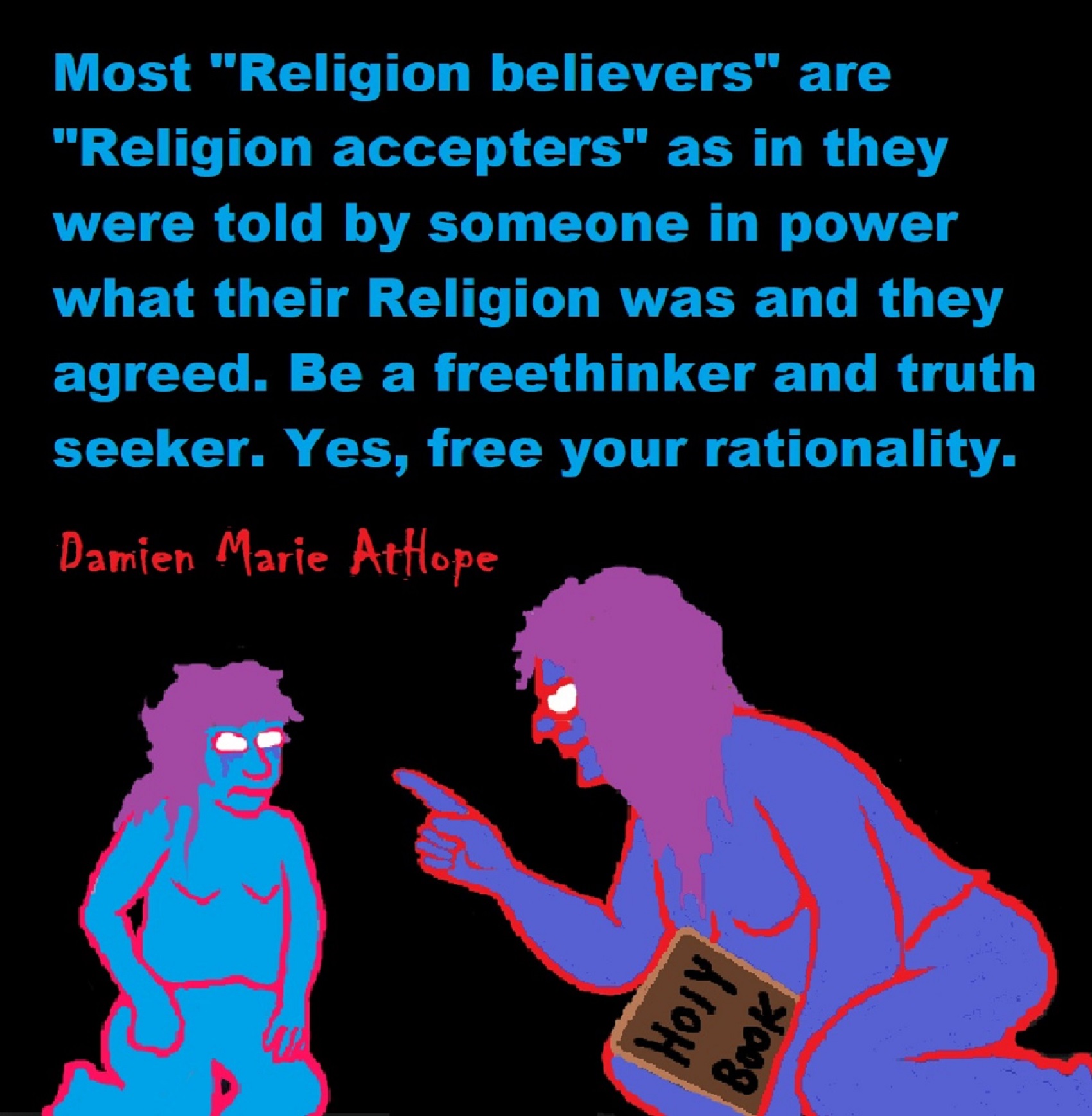

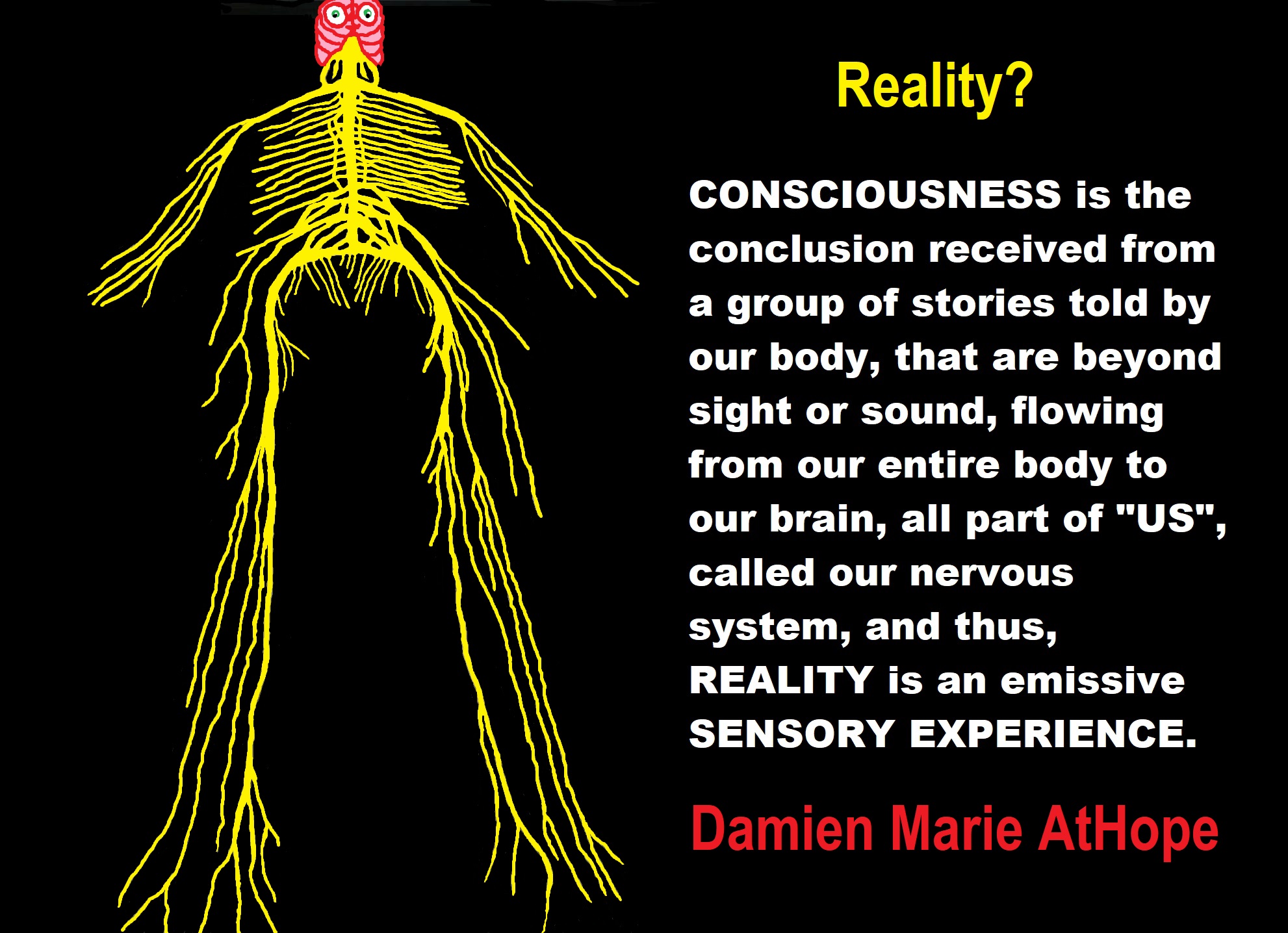

- Addressing a Theistic Philosopher with Fallacious Thinking
- Ignostic Atheist: Do you Have a Coherent Definition of god?
- Firebrand Atheist Dealing with Christian, Threat Prayers
- Caring Firebrand Axiological Atheist, Antitheist, and Antireligionist as a Valuized Ethical Duty.
- Good Belief-Etiquette = Disciplined-Rationality (addressing The Ethics of Belief)
- Addressing The Ethics of Belief and Logical Fallacies
- 40,000 years ago “first seeming use of a Totem” ancestor, animal, and possible pre-goddess worship?
- Out of Africa: “the evolution of religion seems tied to the movement of people”
- Dating the BIBLE: naming names and telling times (written less than 3,000 years ago, provable to 2,200 years ago)

People don’t commonly teach religious history, even that of their own claimed religion. No, rather they teach a limited “pro their religion” history of their religion from a religious perspective favorable to the religion of choice.
We are like believing machines we vacuum up ideas, like Velcro sticks to almost everything. We accumulate beliefs that we allow to negatively influence our lives, often without realizing it. Our willingness must be to alter skewed beliefs that impend our balance or reason, which allows us to achieve new positive thinking and accurate outcomes.

My thoughts on Religion Evolution with external links for more info:
- (Pre-Animism Africa mainly, but also Europe, and Asia at least 300,000 years ago), (Pre-Animism – Oxford Dictionaries)
- (Animism Africa around 100,000 years ago), (Animism – Britannica.com)
- (Totemism Europe around 50,000 years ago), (Totemism – Anthropology)
- (Shamanism Siberia around 30,000 years ago), (Shamanism – Britannica.com)
- (Paganism Turkey around 12,000 years ago), (Paganism – BBC Religion)
- (Progressed Organized Religion “Institutional Religion” Egypt around 5,000 years ago), (Ancient Egyptian Religion – Britannica.com)
- (CURRENT “World” RELIGIONS after 4,000 years ago) (Origin of Major Religions – Sacred Texts)
- (Early Atheistic Doubting at least by 2,600 years ago) (History of Atheism – Wikipedia)
“Religion is an Evolved Product” and Yes, Religion is Like Fear Given Wings…
Atheists talk about gods and religions for the same reason doctors talk about cancer, they are looking for a cure, or a firefighter talks about fires because they burn people and they care to stop them. We atheists too often feel a need to help the victims of mental slavery, held in the bondage that is the false beliefs of gods and the conspiracy theories of reality found in religions.
Understanding Religion Evolution:
- Pre-Animism (at least 300,000 years ago)
- Animism (Africa: 100,000 years ago)
- Totemism (Europe: 50,000 years ago)
- Shamanism (Siberia: 30,000 years ago)
- Paganism (Turkey: 12,000 years ago)
- Progressed organized religion (Egypt: 5,000 years ago), (Egypt, the First Dynasty 5,150 years ago)
- CURRENT “World” RELIGIONS (after 4,000 years ago)
- Early Atheistic Doubting (at least by 2,600 years ago)
“An Archaeological/Anthropological Understanding of Religion Evolution”
It seems ancient peoples had to survived amazing threats in a “dangerous universe (by superstition perceived as good and evil),” and human “immorality or imperfection of the soul” which was thought to affect the still living, leading to ancestor worship. This ancestor worship presumably led to the belief in supernatural beings, and then some of these were turned into the belief in gods. This feeble myth called gods were just a human conceived “made from nothing into something over and over, changing, again and again, taking on more as they evolve, all the while they are thought to be special,” but it is just supernatural animistic spirit-belief perceived as sacred.
Quick Evolution of Religion?
Pre-Animism (at least 300,000 years ago) pre-religion is a beginning that evolves into later Animism. So, Religion as we think of it, to me, all starts in a general way with Animism (Africa: 100,000 years ago) (theoretical belief in supernatural powers/spirits), then this is physically expressed in or with Totemism (Europe: 50,000 years ago) (theoretical belief in mythical relationship with powers/spirits through a totem item), which then enlists a full-time specific person to do this worship and believed interacting Shamanism (Siberia/Russia: 30,000 years ago) (theoretical belief in access and influence with spirits through ritual), and then there is the further employment of myths and gods added to all the above giving you Paganism (Turkey: 12,000 years ago) (often a lot more nature-based than most current top world religions, thus hinting to their close link to more ancient religious thinking it stems from). My hypothesis is expressed with an explanation of the building of a theatrical house (modern religions development). Progressed organized religion (Egypt: 5,000 years ago) with CURRENT “World” RELIGIONS (after 4,000 years ago).
Historically, in large city-state societies (such as Egypt or Iraq) starting around 5,000 years ago culminated to make religion something kind of new, a sociocultural-governmental-religious monarchy, where all or at least many of the people of such large city-state societies seem familiar with and committed to the existence of “religion” as the integrated life identity package of control dynamics with a fixed closed magical doctrine, but this juggernaut integrated religion identity package of Dogmatic-Propaganda certainly did not exist or if developed to an extent it was highly limited in most smaller prehistoric societies as they seem to lack most of the strong control dynamics with a fixed closed magical doctrine (magical beliefs could be at times be added or removed). Many people just want to see developed religious dynamics everywhere even if it is not. Instead, all that is found is largely fragments until the domestication of religion.
Religions, as we think of them today, are a new fad, even if they go back to around 6,000 years in the timeline of human existence, this amounts to almost nothing when seen in the long slow evolution of religion at least around 70,000 years ago with one of the oldest ritual worship. Stone Snake of South Africa: “first human worship” 70,000 years ago. This message of how religion and gods among them are clearly a man-made thing that was developed slowly as it was invented and then implemented peace by peace discrediting them all. Which seems to be a simple point some are just not grasping how devastating to any claims of truth when we can see the lie clearly in the archeological sites.
I wish people fought as hard for the actual values as they fight for the group/clan names political or otherwise they think support values. Every amount spent on war is theft to children in need of food or the homeless kept from shelter.
Here are several of my blog posts on history:
- To Find Truth You Must First Look
- (Magdalenian/Iberomaurusian) Connections to the First Paganists of the early Neolithic Near East Dating from around 17,000 to 12,000 Years Ago
- Natufians: an Ancient People at the Origins of Agriculture and Sedentary Life
- Possible Clan Leader/Special “MALE” Ancestor Totem Poles At Least 13,500 years ago?
- Jewish People with DNA at least 13,200 years old, Judaism, and the Origins of Some of its Ideas
- Baltic Reindeer Hunters: Swiderian, Lyngby, Ahrensburgian, and Krasnosillya cultures 12,020 to 11,020 years ago are evidence of powerful migratory waves during the last 13,000 years and a genetic link to Saami and the Finno-Ugric peoples.
- The Rise of Inequality: patriarchy and state hierarchy inequality
- Fertile Crescent 12,500 – 9,500 Years Ago: fertility and death cult belief system?
- 12,400 – 11,700 Years Ago – Kortik Tepe (Turkey) Pre/early-Agriculture Cultic Ritualism
- Ritualistic Bird Symbolism at Gobekli Tepe and its “Ancestor Cult”
- Male-Homosexual (female-like) / Trans-woman (female) Seated Figurine from Gobekli Tepe
- Could a 12,000-year-old Bull Geoglyph at Göbekli Tepe relate to older Bull and Female Art 25,000 years ago and Later Goddess and the Bull cults like Catal Huyuk?
- Sedentism and the Creation of goddesses around 12,000 years ago as well as male gods after 7,000 years ago.
- Alcohol, where Agriculture and Religion Become one? Such as Gobekli Tepe’s Ritualistic use of Grain as Food and Ritual Drink
- Neolithic Ritual Sites with T-Pillars and other Cultic Pillars
- Paganism: Goddesses around 12,000 years ago then Male Gods after 7,000 years ago
- First Patriarchy: Split of Women’s Status around 12,000 years ago & First Hierarchy: fall of Women’s Status around 5,000 years ago.
- Natufians: an Ancient People at the Origins of Agriculture and Sedentary Life
- J DNA and the Spread of Agricultural Religion (paganism)
- Paganism: an approximately 12,000-year-old belief system
- Paganism 12,000 years old: related to “Anarchism and Socialism” (Pre-Capitalism)
- Shaman burial in Israel 12,000 years ago and the Shamanism Phenomena
- Need to Mythicized: gods and goddesses
- 12,000 – 7,000 Years Ago – Paleo-Indian Culture (The Americas)
- 12,000 – 2,000 Years Ago – Indigenous-Scandinavians (Nordic)
- Norse did not wear helmets with horns?
- Pre-Pottery Neolithic Skull Cult around 11,500 to 8,400 Years Ago?
- 10,400 – 10,100 Years Ago, in Turkey the Nevail Cori Religious Settlement
- 9,000-6,500 Years Old Submerged Pre-Pottery/Pottery Neolithic Ritual Settlements off Israel’s Coast
- Catal Huyuk “first religious designed city” around 9,500 to 7,700 years ago (Turkey)
- Cultic Hunting at Catal Huyuk “first religious designed city”
- Special Items and Art as well as Special Elite Burials at Catal Huyuk
- New Rituals and Violence with the appearance of Pottery and People?
- Haplogroup N and its related Uralic Languages and Cultures
- Ainu people, Sámi people, Native Americans, the Ancient North Eurasians, and Paganistic-Shamanism with Totemism
- Ideas, Technology and People from Turkey, Europe, to China and Back again 9,000 to 5,000 years ago?
- First Pottery of Europe and the Related Cultures
- 9,000 years old Neolithic Artifacts Judean Desert and Hills Israel
- 9,000-7,000 years-old Sex and Death Rituals: Cult Sites in Israel, Jordan, and the Sinai
- 9,000-8500 year old Horned Female shaman Bad Dürrenberg Germany
- Neolithic Jewelry and the Spread of Farming in Europe Emerging out of West Turkey
- 8,600-year-old Tortoise Shells in Neolithic graves in central China have Early Writing and Shamanism
- Swing of the Mace: the rise of Elite, Forced Authority, and Inequality begin to Emerge 8,500 years ago?
- Migrations and Changing Europeans Beginning around 8,000 Years Ago
- My “Steppe-Anatolian-Kurgan hypothesis” 8,000/7,000 years ago
- Around 8,000-year-old Shared Idea of the Mistress of Animals, “Ritual” Motif
- Pre-Columbian Red-Paint (red ochre) Maritime Archaic Culture 8,000-3,000 years ago
- 7,522-6,522 years ago Linear Pottery culture which I think relates to Arcane Capitalism’s origins
- Arcane Capitalism: Primitive socialism, Primitive capital, Private ownership, Means of production, Market capitalism, Class discrimination, and Petite bourgeoisie (smaller capitalists)
- 7,500-4,750 years old Ritualistic Cucuteni-Trypillian culture of Moldova, Romania, and Ukraine
- Roots of a changing early society 7,200-6,700 years ago Jordan and Israel
- Agriculture religion (Paganism) with farming reached Britain between about 7,000 to 6,500 or so years ago and seemingly expressed in things like Western Europe’s Long Barrows
- My Thoughts on Possible Migrations of “R” DNA and Proto-Indo-European?
- “Millet” Spreading from China 7,022 years ago to Europe and related Language may have Spread with it leading to Proto-Indo-European
- Proto-Indo-European (PIE), ancestor of Indo-European languages: DNA, Society, Language, and Mythology
- The Dnieper–Donets culture and Asian varieties of Millet from China to the Black Sea region of Europe by 7,022 years ago
- Kurgan 6,000 years ago/dolmens 7,000 years ago: funeral, ritual, and other?
- 7,020 to 6,020-year-old Proto-Indo-European Homeland of Urheimat or proposed home of their Language and Religion
- Ancient Megaliths: Kurgan, Ziggurat, Pyramid, Menhir, Trilithon, Dolman, Kromlech, and Kromlech of Trilithons
- The Mytheme of Ancient North Eurasian Sacred-Dog belief and similar motifs are found in Indo-European, Native American, and Siberian comparative mythology
- Elite Power Accumulation: Ancient Trade, Tokens, Writing, Wealth, Merchants, and Priest-Kings
- Sacred Mounds, Mountains, Kurgans, and Pyramids may hold deep connections?
- Between 7,000-5,000 Years ago, rise of unequal hierarchy elite, leading to a “birth of the State” or worship of power, strong new sexism, oppression of non-elites, and the fall of Women’s equal status
- Paganism 7,000-5,000 years old: related to “Anarchism and Socialism” (Capitalism) (World War 0) Elite & their slaves
- Hell and Underworld mythologies starting maybe as far back as 7,000 to 5,000 years ago with the Proto-Indo-Europeans?
- The First Expression of the Male God around 7,000 years ago?
- White (light complexion skin) Bigotry and Sexism started 7,000 years ago?
- Around 7,000-year-old Shared Idea of the Divine Bird (Tutelary and/or Trickster spirit/deity), “Ritual” Motif
- Nekhbet an Ancient Egyptian Vulture Goddess and Tutelary Deity
- 6,720 to 4,920 years old Ritualistic Hongshan Culture of Inner Mongolia with 5,000-year-old Pyramid Mounds and Temples
- First proto-king in the Balkans, Varna culture around 6,500 years ago?
- 6,500–5,800 years ago in Israel Late Chalcolithic (Copper Age) Period in the Southern Levant Seems to Express Northern Levant Migrations, Cultural and Religious Transfer
- KING OF BEASTS: Master of Animals “Ritual” Motif, around 6,000 years old or older…
- Around 6000-year-old Shared Idea of the Solid Wheel & the Spoked Wheel-Shaped Ritual Motif
- “The Ghassulian Star,” a mysterious 6,000-year-old mural from Jordan; a Proto-Star of Ishtar, Star of Inanna or Star of Venus?
- Religious/Ritual Ideas, including goddesses and gods as well as ritual mounds or pyramids from Northeastern Asia at least 6,000 years old, seemingly filtering to Iran, Iraq, the Mediterranean, Europe, Egypt, and the Americas?
- Maykop (5,720–5,020 years ago) Caucasus region Bronze Age culture-related to Copper Age farmers from the south, influenced by the Ubaid period and Leyla-Tepe culture, as well as influencing the Kura-Araxes culture
- 5-600-year-old Tomb, Mummy, and First Bearded Male Figurine in a Grave
- Kura-Araxes Cultural 5,520 to 4,470 years old DNA traces to the Canaanites, Arabs, and Jews
- Minoan/Cretan (Keftiu) Civilization and Religion around 5,520 to 3,120 years ago
- Evolution Of Science at least by 5,500 years ago
- 5,500 Years old birth of the State, the rise of Hierarchy, and the fall of Women’s status
- “Jiroft culture” 5,100 – 4,200 years ago and the History of Iran
- Stonehenge: Paganistic Burial and Astrological Ritual Complex, England (5,100-3,600 years ago)
- Around 5,000-year-old Shared Idea of the “Tree of Life” Ritual Motif
- Complex rituals for elite, seen from China to Egypt, at least by 5,000 years ago
- Around 5,000 years ago: “Birth of the State” where Religion gets Military Power and Influence
- The Center of the World “Axis Mundi” and/or “Sacred Mountains” Mythology Could Relate to the Altai Mountains, Heart of the Steppe
- Progressed organized religion starts, an approximately 5,000-year-old belief system
- China’s Civilization between 5,000-3,000 years ago, was a time of war and class struggle, violent transition from free clans to a Slave or Elite society
- Origin of Logics is Naturalistic Observation at least by around 5,000 years ago.
- Paganism 5,000 years old: progressed organized religion and the state: related to “Anarchism and Socialism” (Kings and the Rise of the State)
- Ziggurats (multi-platform temples: 4,900 years old) to Pyramids (multi-platform tombs: 4,700 years old)
- Did a 4,520–4,420-year-old Volcano In Turkey Inspire the Bible God?
- Finland’s Horned Shaman and Pre-Horned-God at least 4,500 years ago?
- 4,000-year-Old Dolmens in Israel: A Connected Dolmen Religious Phenomenon?
- Creation myths: From chaos, Ex nihilo, Earth-diver, Emergence, World egg, and World parent
- Bronze Age “Ritual” connections of the Bell Beaker culture with the Corded Ware/Single Grave culture, which were related to the Yamnaya culture and Proto-Indo-European Languages/Religions
- Low Gods (Earth/ Tutelary deity), High Gods (Sky/Supreme deity), and Moralistic Gods (Deity enforcement/divine order)
- The exchange of people, ideas, and material-culture including, to me, the new god (Sky Father) and goddess (Earth Mother) religion between the Cucuteni-Trypillians and others which is then spread far and wide
- Koryaks: Indigenous People of the Russian Far East and Big Raven myths also found in Tlingit, Haida, Tsimshian, and other Indigenous People of North America
- 42 Principles Of Maat (Egyptian Goddess of the justice) around 4,400 years ago, 2000 Years Before Ten Commandments
- “Happy Easter” Well Happy Eostre/Ishter
- 4,320-3,820 years old “Shimao” (North China) site with Totemistic-Shamanistic Paganism and a Stepped Pyramid
- 4,250 to 3,400 Year old Stonehenge from Russia: Arkaim?
- 4,100-year-old beaker with medicinal & flowering plants in a grave of a woman in Scotland
- Early European Farmer ancestry, Kelif el Boroud people with the Cardial Ware culture, and the Bell Beaker culture Paganists too, spread into North Africa, then to the Canary Islands off West Africa
- Flood Accounts: Gilgamesh epic (4,100 years ago) Noah in Genesis (2,600 years ago)
- Paganism 4,000 years old: related to “Anarchism and Socialism” (First Moralistic gods, then the Origin time of Monotheism)
- When was the beginning: TIMELINE OF CURRENT RELIGIONS, which start around 4,000 years ago.
- Early Religions Thought to Express Proto-Monotheistic Systems around 4,000 years ago
- Kultepe? An archaeological site with a 4,000 years old women’s rights document.
- Single God Religions (Monotheism) = “Man-o-theism” started around 4,000 years ago with the Great Sky Spirit/God Tiān (天)?
- Confucianism’s Tiān (Shangdi god 4,000 years old): Supernaturalism, Pantheism or Theism?
- Yes, Your Male God is Ridiculous
- Mythology, a Lunar Deity is a Goddess or God of the Moon
- Sacred Land, Hills, and Mountains: Sami Mythology (Paganistic Shamanism)
- Horse Worship/Sacrifice: mythical union of Ruling Elite/Kingship and the Horse
- The Amorite/Amurru people’s God Amurru “Lord of the Steppe”, relates to the Origins of the Bible God?
- Bronze Age Exotic Trade Routes Spread Quite Far as well as Spread Religious Ideas with Them
- Sami and the Northern Indigenous Peoples Landscape, Language, and its Connection to Religion
- Prototype of Ancient Analemmatic Sundials around 3,900-3,150 years ago and a Possible Solar Connection to gods?
- Judaism is around 3,450 or 3,250 years old. (“Paleo-Hebrew” 3,000 years ago and Torah 2,500 years ago)
- The Weakening of Ancient Trade and the Strengthening of Religions around 3000 years ago?
- Are you aware that there are religions that worship women gods, explain now religion tears women down?
- Animistic, Totemistic, and Paganistic Superstition Origins of bible god and the bible’s Religion.
- Myths and Folklore: “Trickster gods and goddesses”
- Jews, Judaism, and the Origins of Some of its Ideas
- An Old Branch of Religion Still Giving Fruit: Sacred Trees
- Dating the BIBLE: naming names and telling times (written less than 3,000 years ago, provable to 2,200 years ago)
- Did a Volcano Inspire the bible god?
- Dené–Yeniseian language, Old Copper Complex, and Pre-Columbian Mound Builders?
- No “dinosaurs and humans didn’t exist together just because some think they are in the bible itself”
- Sacred Shit and Sacred Animals?
- Everyone Killed in the Bible Flood? “Nephilim” (giants)?
- Hey, Damien dude, I have a question for you regarding “the bible” Exodus.
- Archaeology Disproves the Bible
- Bible Battle, Just More, Bible Babble
- The Jericho Conquest lie?
- Canaanites and Israelites?
- Accurate Account on how did Christianity Began?
- Let’s talk about Christianity.
- So the 10 commandments isn’t anything to go by either right?
- Misinformed christian
- Debunking Jesus?
- Paulism vs Jesus
- Ok, you seem confused so let’s talk about Buddhism.
- Unacknowledged Buddhism: Gods, Savior, Demons, Rebirth, Heavens, Hells, and Terrorism
- His Foolishness The Dalai Lama
- Yin and Yang is sexist with an ORIGIN around 2,300 years ago?
- I Believe Archaeology, not Myths & Why Not, as the Religious Myths Already Violate Reason!
- Archaeological, Scientific, & Philosophic evidence shows the god myth is man-made nonsense.
- Aquatic Ape Theory/Hypothesis? As Always, Just Pseudoscience.
- Ancient Aliens Conspiracy Theorists are Pseudohistorians
- The Pseudohistoric and Pseudoscientific claims about “Bakoni Ruins” of South Africa
- Why do people think Religion is much more than supernaturalism and superstitionism?
- Religion is an Evolved Product
- Was the Value of Ancient Women Different?
- 1000 to 1100 CE, human sacrifice Cahokia Mounds a pre-Columbian Native American site
- Feminist atheists as far back as the 1800s?
- Promoting Religion as Real is Mentally Harmful to a Flourishing Humanity
- Screw All Religions and Their Toxic lies, they are all fraud
- Forget Religions’ Unfounded Myths, I Have Substantiated “Archaeology Facts.”
- Religion Dispersal throughout the World
- I Hate Religion Just as I Hate all Pseudoscience
- Exposing Scientology, Eckankar, Wicca and Other Nonsense?
- Main deity or religious belief systems
- Quit Trying to Invent Your God From the Scraps of Science.
- Archaeological, Scientific, & Philosophic evidence shows the god myth is man-made nonsense.
- Ancient Alien Conspiracy Theorists: Misunderstanding, Rhetoric, Misinformation, Fabrications, and Lies
- Misinformation, Distortion, and Pseudoscience in Talking with a Christian Creationist
- Judging the Lack of Goodness in Gods, Even the Norse God Odin
- Challenging the Belief in God-like Aliens and Gods in General
- A Challenge to Christian use of Torture Devices?
- Yes, Hinduism is a Religion
- Trump is One of the Most Reactionary Forces of Far-right Christian Extremism
- Was the Bull Head a Symbol of God? Yes!
- Primate Death Rituals
- Christian – “God and Christianity are objectively true”
- Australopithecus afarensis Death Ritual?
- You Claim Global Warming is a Hoax?
- Doubter of Science and Defamer of Atheists?
- I think that sounds like the Bible?
- History of the Antifa (“anti-fascist”) Movements
- Indianapolis Anti-Blasphemy Laws #Free Soheil Rally
- Damien, you repeat the golden rule in so many forms then you say religion is dogmatic?
- Science is a Trustable Methodology whereas Faith is not Trustable at all!
- Was I ever a believer, before I was an atheist?
- Atheists rise in reason
- Mistrust of science?
- Open to Talking About the Definition of ‘God’? But first, we address Faith.
- ‘United Monarchy’ full of splendor and power – Saul, David, and Solomon? Most likely not.
- Is there EXODUS ARCHAEOLOGY? The short answer is “no.”
- Lacking Proof of Bigfoots, Unicorns, and Gods is Just a Lack of Research?
- Religion and Politics: Faith Beliefs vs. Rational Thinking
- Hammer of Truth that lying pig RELIGION: challenged by an archaeologist
- “The Hammer of Truth” -ontology question- What do You Mean by That?
- Navigation of a bad argument: Ad Hominem vs. Attack
- Why is it Often Claimed that Gods have a Gender?
- Why are basically all monotheistic religions ones that have a male god?
- Shifting through the Claims in support of Faith
- Dear Mr. AtHope, The 20th Century is an Indictment of Secularism and a Failed Atheist Century
- An Understanding of the Worldwide Statistics and Dynamics of Terrorist Incidents and Suicide Attacks
- Intoxication and Evolution? Addressing and Assessing the “Stoned Ape” or “Drunken Monkey” Theories as Catalysts in Human Evolution
- Sacred Menstrual cloth? Inanna’s knot, Isis knot, and maybe Ma’at’s feather?
- Damien, why don’t the Hebrews accept the bible stories?
- Dealing with a Troll and Arguing Over Word Meaning
- Knowledge without Belief? Justified beliefs or disbeliefs worthy of Knowledge?
- Afrocentrism and African Religions
- Crecganford @crecganford offers history & stories of the people, places, gods, & culture
- Empiricism-Denier?
I am not an academic. I am a revolutionary that teaches in public, in places like social media, and in the streets. I am not a leader by some title given but from my commanding leadership style of simply to start teaching everywhere to everyone, all manner of positive education.






Damien Marie AtHope (Said as “At” “Hope”)/(Autodidact Polymath but not good at math):
Axiological Atheist, Anti-theist, Anti-religionist, Secular Humanist, Rationalist, Writer, Artist, Jeweler, Poet, “autodidact” Philosopher, schooled in Psychology, and “autodidact” Armchair Archaeology/Anthropology/Pre-Historian (Knowledgeable in the range of: 1 million to 5,000/4,000 years ago). I am an anarchist socialist politically. Reasons for or Types of Atheism
My Website, My Blog, & Short-writing or Quotes, My YouTube, Twitter: @AthopeMarie, and My Email: damien.marie.athope@gmail.com

